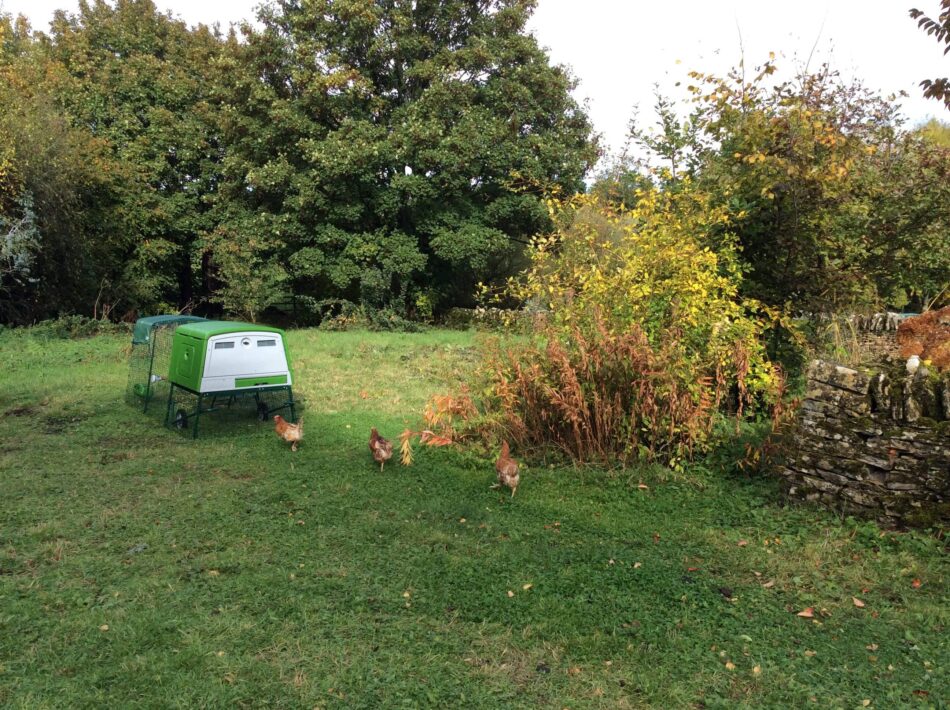
Why keep chickens in retirement?
Whilst retirement is undoubtedly a relaxing and well-deserved break, this stage of life can also bring on feelings of loneliness, which is why many, like Mary, take on a new hobby or get a pet. Chickens make for the ultimate retirement animals, being excellent companions, low maintenance, and come with the added bonus of providing a delicious breakfast every day! After all, no one ever said you had to be a spring chicken to keep them!
We recently spoke to Mary who has taken up chicken keeping during retirement, after deciding to adopt three ex-caged birds from one of her local chicken rescue centers in September earlier this year. When asked if she would be happy to share her experience so far, she couldn’t wait to tell us all about her flock and the journey they’ve all been on.
What you’ll need to start keeping chickens in retirement
Getting started on your chicken keeping journey is easy with the right equipment. A low maintenance and easy to clean chicken coop, like the Eglu Cube, will give you more time to enjoy your new gardening companions. This raised chicken coop is also the perfect height for collecting eggs and pulling out the droppings tray to tip into your compost bin. The Eglu Cube house is big enough for 3 – 6 large hens, and if you choose a good laying breed or rescue ex-battery hens, that will get you 2- 4 fresh eggs a day! Extend the integral run at any time to give them more secure space, or attach to a larger Walk In Chicken Run so you can easily spend time with your feathered friends.
Add an Automatic Chicken Coop Door to the house to make chicken keeping even easier. The Autodoor will let your chickens out at sunrise, and shut them back in at sunset, so you don’t need to change your routine or worry about them when out and about.
What’s it like keeping chickens in retirement?
I’ve had them for about 8 weeks now. All of it’s quite new to me really! It’s the first time I’ve had chickens and I haven’t handled chickens before. I do think it was quite helpful having the What The Cluck book, which has been great and it’s been nice to refer back to. It’s been great fun and a learning curve.
How was setting up your Omlet chicken coop and run?
I rather left the task to my husband but the Omlet manuals are very comprehensive! I think the nesting box is excellent and it’s lovely to have the automatic door to let them out first thing in the morning and make sure they’re secure at night. It’s great being able to move [the coop] about too!
“Funnily enough, it’s quite the motivation to get up in the morning. They become a reason to get up early.”
Have you been doing a lot of cooking with the eggs?
Well, yes – a fair bit! I’ve really noticed over the two months I’ve had them the yolk has really yellowed/oranged up. It’s been very nice to be able to give family and friends eggs and everyone says how lovely they taste.
Has there been anything unexpected about chicken-keeping?
One thing I have been concerned about is that I have 2 cats – both of them are hunters. I was a bit concerned about how they would be but they’ve actually given them a very wide berth. They simply sort of look at them and go round the end of the garden!
So, do you think retirement is a good time to keep chickens?
Oh yes because you’re around a whole lot more! I love being outside and gardening anyway, and now it’s definitely an added incentive to be out there, wasting my time, watching them. They all sort of come and see what you’re doing and if you turn anything over, they’re in there looking for delicacies.
“They are fascinating and entertaining and terrible time wasters!”
For Mary, chickens have introduced new joy to her garden, even more reason to spend time outside and fresh eggs for her bakes. As she continues her journey, we’ll be catching up again in a few month’s time, so stayed tuned to read the next part of Mary’s retirement chicken keeping adventure!
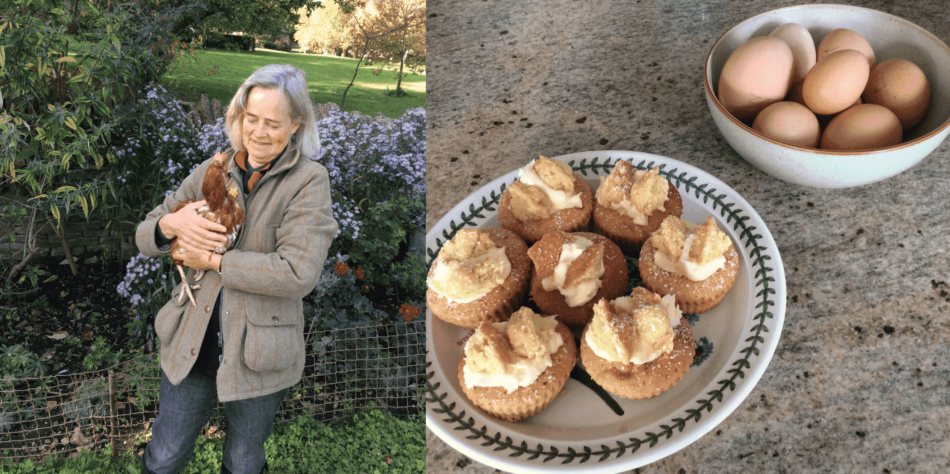
Mary’s Omlet setup was gifted by Omlet.
This entry was posted in Chickens
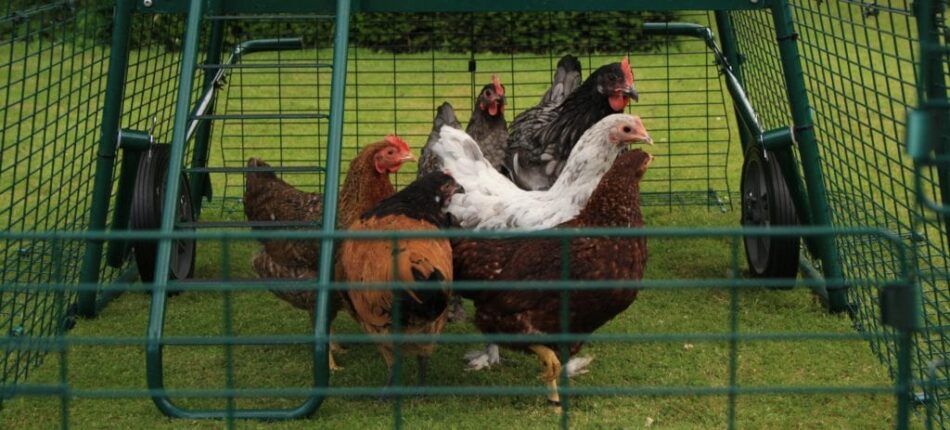
As a chicken keeper, you’re probably familiar with the disease known as avian flu, but have you taken steps to prevent the illness in your hens during the current outbreak? With so many flocks being affected, both small and commercial-sized, it raises many questions about the safety of our chickens. The most pressing question being: what can I do to protect my chickens from avian flu?
Thankfully, there are precautions that can be taken to minimize the risk of infection in backyard chickens. As with any viral outbreak, reports of avian flu often come with misinformation and fear-inducing articles on their heels. But with education, preparation, and helpful information, chicken keeping can be just as enjoyable during this avian flu outbreak as it was before.
A large chicken coop with a covered walk in chicken run is one of the best combinations to house your chickens during this current outbreak of bird flu. With the right equipment, your chickens’ chances of contracting avian flu can be greatly mitigated.
What is avian flu?
Avian flu (also known as “bird flu”), is an influenza virus that affects birds of all species. The origination of these types of viruses in the US can be dated back to the early 1900s, though they would not be identified as influenza strains until the 1930s. The current strain in circulation is H5N1, which is also known as “Hong Kong bird flu”, as it was first documented in China in 1996. It has since been labeled a HPAI (highly pathogenic avian influenza) virus, differentiating it from LPAI (low pathogenic avian influenza viruses). LPAI viruses cause little to no symptoms in birds, but with the high mortality rates associated with HPAI in poultry especially, preventing avian flu in chickens is of the utmost importance.
The method of transmission for both LPAI and HPAI viruses is the same: through wild migratory birds. Waterfowl in particular have been found to be carriers of the latest avian influenza outbreak. The virus does not cause severe symptoms in wild birds, and is shed through nasal discharge, saliva, and feces of infected fowl. Once infected, H5N1 avian flu has nearly a 100% mortality rate for domestic chickens and turkey. Keeping your hens in a proper chicken setup can protect them from this statistic.
6 Ways to Prevent Avian Flu in Chickens
The adage: “an ounce of prevention is worth a pound of cure” is fitting for avian flu, and there are multiple preventative measures you can take to protect your backyard chickens. When creating an environment that will protect against the virus, first and foremost you will want to bring in any free-ranging chickens and keep them contained in a space that is easier to shield against bird flu.
To take the best stand against avian flu:
- Invest in a well-made, large chicken coop such as the Eglu Cube Chicken Coop. Cleaning will be a regular part of keeping pathogens at bay, and having a coop that can have all components removed and washed will go a long way in keeping your hens’ house disinfected.
- Keep your chicken tractor inside or attached to a chicken run that has plenty of space, such as a walk in chicken run. Your chickens will be spending lots of time in their run, so space is essential. The more space you can offer, the better! If you need help deciding what size run to get for your chickens, feel free to contact our team of experts in customer service and we will be happy to help.
- A cover for your chicken run one of the most important products you’ll need to keep your chickens as safe as possible. Since avian flu is spread through the droppings, nasal discharge and saliva of wild birds, preventing these substances from entering your chicken runs will be instrumental to their safety. Weather-proof chicken run coverings are the best option, as they will not allow any fluids to penetrate them.
- Wild animals such as foxes and skunks have been documented to carry avian flu after coming into contact with diseased birds. Consider increasing the security of your backyard fence to prevent wildlife from passing through your yard. If your chickens are housed in an Omlet chicken coop and run with anti-dig skirting they’ll be safe from wildlife tunneling in, but if you don’t already have a perimeter fence, you can create an extra barrier around your chickens’ area with chicken fencing.
- Advocate for your chickens. Discourage visitors from entering your flock’s area – especially those with their own chickens. Shoes can carry the virus, so even visits of your own warrant a wardrobe change before entering your chickens’ run. Bleaching the bottoms of your shoes or boots routinely will keep them clean for your chicken-visits and could prevent avian flu.
- Quarantine any new chickens for a minimum of 10 days before introducing them to the rest of your flock. Be sure that your separate coop and run have the same measures to prevent avian flu in chickens as your primary setup to avoid infection during their quarantine period.
Keeping your flock busy
While your chickens are adjusting to being contained in a run, be sure to give them stimulating activities that will foster natural instincts. Boredom is a real issue for chickens, but a busy chicken is a happy chicken!
Some ideas for keeping your hens entertained throughout the day include:
- Keep food and water under cover of the coop, or purchase covered feeding dishes and waterers with drinking cups to prevent drawing attention from aerial guests.
- Give your hens some chicken toys, chicken perches, or a chicken swing to keep them occupied in their run. This is especially important for chickens who are used to free-ranging, as adjusting to boundaries can be frustrating to them initially. Offer special treats tossed into a pile of straw or hay to encourage natural foraging behavior, or configure several chicken perches into an aerial playground to keep them active.
- Offer hay or straw in piles to toss chicken treats or kitchen scraps in. Your chickens will enjoy scratching and pecking around in the textured substrate!
Once your chickens are safely within the boundaries you’ve set, monitor for any signs or symptoms that could indicate infection with avian flu.
Signs and symptoms of avian flu in chickens
As with any illness, any unusual symptoms or signs of illness should be monitored and reported to your veterinarian. The following symptoms are seen in chickens with avian flu, and warrant a call to the vet right away:
- Swelling of wattles and combs, head or neck, or around the eyes
- Discolored (mottled, blotchy, or blue) combs or wattles
- Purple, red, or blue-tinged legs or of the visible skin on the head
- Extreme diarrhea
- Labored breathing, sneezing, coughing, or wheezing
H5N1 avian flu causes death very quickly in chickens and turkeys in particular. If you have other birds such as ducks or geese, they are the ideal hosts for avian flu. They may display mild to no symptoms when infected with H5N1, but can easily pass it to your chickens. Be sure to house any waterfowl far away from your chickens with no contact between the two.
What to do if you suspect bird flu
Other illnesses can mimic the symptoms of avian flu in chickens, so be sure not to jump to conclusions if one or more of your hens appear under the weather! Always contact your veterinarian if you suspect illness in your flock. You’ll also want to keep some PPE (personal protective equipment) items on hand in case you need to care for sick chickens. Have disposable gloves, masks, and gowns along with your chicken first aid kit.
After putting on your PPE, relocate any sick chickens to a quarantine coop far away from the rest of the flock. Keep notes of when the symptoms started, along with their severity, changes, etc. The more information you can give your veterinarian, the better!
Dispose of PPE after each visit to ill flock-members. Wash your hands thoroughly with soap and water, and clean the bottoms of your shoes with bleach after exiting the run. While extremely rare, humans can contract avian influenza after handling or caring for chickens infected with the virus. Use caution when handling sick or deceased chickens, and call your doctor should you notice any concerning symptoms of your own.
If avian flu is suspected in your flock, your veterinarian will take samples to send out for laboratory testing to confirm a diagnosis. Should your flock be infected, your state will inform you of next steps.
Is there a cure for avian flu?
As of now, supportive therapy is the only treatment for chickens once they become infected. However, the virus progresses so rapidly that there is often not enough time to begin treatment. No vaccines are currently approved for use in chickens against H5N1 in the US, but trials are underway to create an effective vaccine for domestic poultry.
The best cure is preventing avian flu in your chickens, as once they have contracted the virus it is nearly 100% fatal. Until the US approves a vaccine to prevent avian flu in poultry, we must remain vigilant in preventative care.
The dos and don’ts of chicken keeping
Even in the worrisome climate that 2022 has brought for chicken keepers, it’s important to remember the positives that come along with owning chickens! Chickens provide fresh eggs, rewarding animal-husbandry opportunities, and enjoyment to people all across the world. If you remember and employ the tips to prevent avian flu in chickens, the rest of your chicken-keeping habits remain the same.
The dos of keeping chickens
- Create an environment that makes caring for your chickens easy and safe
- Use common sense when caring for your chickens
- Call your veterinarian with any questions or concerns
- Take necessary precautions when they are warranted
- Enjoy visiting with and caring for your flock
The don’ts of keeping chickens
- Panic or stress over the current events
- Avoid your chickens or dread caring for them
- Assume the worst when a chicken appears “off”
- Add new flock members without first quarantining them
- Forget to continue having fun with your chickens!
Can my other pets get avian flu?
There have been documented cases of mammals other than humans contracting avian flu, but it is rare. Don’t let your other pets enter the chicken run, and keep them away from wild birds when possible. Do you take hikes at the lake, a walk around a neighborhood pond, or any other locations where your dog may encounter the feces of waterfowl? Be sure to wash their feet thoroughly with a dog-safe shampoo or regular dish soap before heading back home.
If a dead bird is found by your dog or cat, discourage them from approaching it. If you’re at home, put on your PPE before disposing of any dead wildlife. Wash your hands, and then bathe your dog or cat if you suspect they touched the animal in question. Contact your veterinarian if your pet exhibits any concerning symptoms within the following days of potential exposure.
If your chickens have been diagnosed with avian flu, discuss with your veterinarian what you should watch for in your dogs, cats, or any other pets that may have had contact with your chickens.
Don’t assume your chickens have avian flu
There’s an expression that began in the medical field that says: “When you hear hoofbeats, think of horses, not zebras.” This phrase is used as a reassurance that just because certain circumstances or symptoms may look or act like something terrible, the usual situation is usually much less dire than initially assumed. Horses are much more common than zebras!
When taking precautions against avian flu, don’t assume that your chickens will be infected, or that it’s a looming threat over your flock. While there is a certain amount of urgency associated with modifying your chickens’ housing to keep them safe, approach it with the mindset of bettering the health and security of your chickens, and not out of fear or the feeling of impending doom!
The reality is that there is an avian flu outbreak, and it can infect your chickens. But, with level-headed preparation, you can rest easy knowing you’ve done all that you can to protect your feathered-family members from this disease!
Omlet can help keep your chickens safe from avian flu
A quality hen house will go a long way when taking precautions against avian flu. Enclosed, well ventilated chicken coops promote good respiratory health and well being in chickens year-round. Easy-to-clean components will make sanitizing your hens’ house a breeze, while ensuring cleanliness and safety.
Providing enrichment for your chickens and maintaining a safe environment will keep chicken-keeping enjoyable – even during an avian flu outbreak. Now more than ever is the time to focus on the positives of chicken ownership and not dwell in fear. Create an avian flu-free space for your chickens, sanitize regularly, and report any symptoms to your veterinarian for a worry-free chicken-keeping lifestyle.

This entry was posted in Chickens
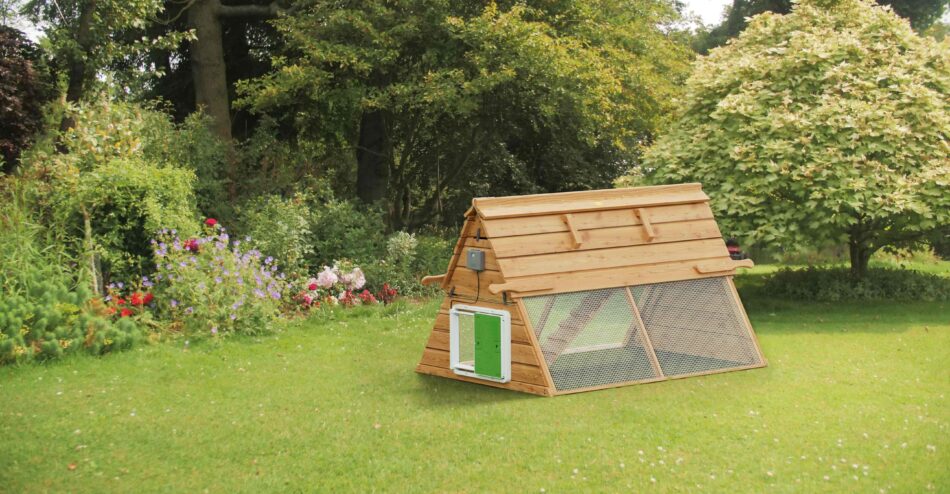
Do you have a wooden chicken coop in need of some home improvements? All wooden coops need routine maintenance and refurbishing – sometimes on a yearly basis. But how long should you expect a wooden chicken coop to last?
Chickens have been kept in various structures throughout history: barns, coops, even baskets! But over time coops have become the most popular hen-housing option, with wood being the most common material used for construction. Wood is easy to work with and relatively inexpensive, which makes it a favorite among DIY enthusiasts and coop supply companies alike. But the downside to wood is that it does not withstand the test of time and will inevitably require upkeep over the years.
When considering whether to make updates to a wooden chicken coop or to start fresh with a new design, several factors should be considered: Do you like the idea of a coop that can be easily moved? Easily cleaned? Resistant to mites, moisture buildup, and predators? If so, changing from a wooden coop to a plastic chicken coop will be a better option!
“If it ain’t broke, don’t fix it.”
This proverb holds true for many things, but wooden chicken coops are not among them! Even if your chickens’ wooden coop seems structurally sound, attention to detail is crucial to the health and wellbeing of your hens. If you notice the following issues with your wooden coop, it’s time to make repairs:
- Moisture buildup, or the presence of mold or mildew
- Sagging boards, gaps, or holes that cause drafts
- Rotting wood
It’s important to remove any affected boards and replace them with treated wood. If the siding or roof of the coop is involved, you’ll need to cut out the affected sections. Rotting wood is not only a hazard to your chickens, it’s also breeding grounds for parasites and bacteria or fungus. Remove any questionable sections of your chickens’ coop as soon as possible!
Small repairs may not be time consuming, but replacing larger sections of a wooden chicken coop requires both time and resources. You’ll also need to evaluate if the affected sections are going to compromise the structural integrity of the rest of the coop. If so, it may be time for a new chicken coop.
Enter: plastic chicken coops
The alternative to traditional wooden coops is the Eglu Cube Chicken Coop. Made from sturdy plastic, these chicken coops are easy to clean, move, are predator resistant, and require zero maintenance. The twin-wall insulation keeps cold and heat out during their respective seasons, while maintaining just the right amount of ventilation to create healthy air circulation. Additionally, these plastic coops can be pressure washed and thoroughly disinfected, creating a much healthier environment for your hens.
The Eglu Cube Chicken Coop never has to be painted, re-roofed, or weather treated like traditional wooden chicken coops – saving countless hours and dollars. It’s easy to assemble, and once erected, this heavy-duty plastic chicken coop is easy to move around the yard with the help of its integrated wheels and handles!
Are your hens happy in their wooden coop? If their coop is drafty, poorly insulated, or harboring mold or parasites, it’s definitely time to make a change!
Eglus for egg-layers
Aside from scoring bonus points for “being different,” Eglu chicken coops also earn high marks among chickens! Providing a cozy space, the Eglu’s insulating design utilizes your hens’ body heat to keep them warm even on the coldest nights. The Eglu Cube and Eglu Go Up Chicken Coops both offer the raised roosting space that chickens seek out at bedtime. Add in an automatic chicken coop door and you’ll be sure your hens are tucked in tight every night!
Plastic surfaces are inhospitable for parasites such as mites that so often plague chickens. And with the unique design of the Eglu, just the right amount of air circulation takes place without letting in drafts. No moisture buildup, mildew, or mold in a well ventilated coop makes for healthy and happy hens.
No more small roosting bars for your birds to balance on overnight – the Eglu Cube has an entire roosting rack complete with a droppings tray that can be easily removed and cleaned. Your hens will appreciate the break their toes receive when they’re able to get as comfy as they please at bedtime!
Eglus for egg-aficionados
Loved by chickens, but adored by their keepers – Eglu chicken coops are an all-in-one solution for flock-tending! Plastic coops don’t require any routine maintenance, and all of our Eglu chicken coops have removable parts for quick, but thorough cleanings. Spray them down with a hose or pressure washer, and finish with a quick spray of chicken-safe disinfectant for a fresh coop in minutes!
Not sure if you love where you decided to put your chickens’ coop? With integrated handles and wheels, the Eglu Cube can be moved with ease by one person! A chicken tractor that doesn’t require helping hands to move is always a win in the chicken-keepers book.
One and done – once an Eglu is assembled, that’s it! No maintenance, painting, removing rotten pieces, or making modifications. From the time the last piece goes into place, an Eglu is ready for hens for many years to come.
Eglus are built for winter
Not just a clever play on words, the Eglu’s unique design offers your hens optimal warmth throughout the cold months. Similar to double-paned windows, the twin-layer walls offer superior insulation by keeping your hens’ body heat in and the cold air out. A pocket of air surrounds the entire Eglu while still maintaining proper ventilation. The result? A toasty warm, well ventilated chicken coop!
In the debate of “Eglu Cube vs Wooden Chicken Coop – Which Will Stay Warmer?”, the Eglu Cube is the clear winner. Wood is too porous to truly insulate, and while spray or roll-insulation can be utilized in wooden coops, the process of layering such material between two sections of wood makes the coop much too heavy to move. Air as an insulator is much lighter and more effective for trapping heat.
No added insulation is needed with an Eglu chicken coop, unless your area has sustained, frigid temperatures. Optional extreme weather jackets can be added as a protective layer in climates that experience severe winter weather. All you need to do to ensure your hens stay warm in their Eglu during winter nights is close them in – the Eglu and your hens’ body heat will do the rest!
Wooden coop vs plastic coop care and upkeep
It’s important to remember that all wooden coops will require ongoing repairs and upkeep. Common wooden coop maintenance includes:
- Replacing weather-worn or rotten boards
- Hosing down or washing, allowing several hours for the wood to dry
- Reapplying paint or weather treatment (must be chicken-safe!)
- Replacing shingles on roofs
- Patching holes created by insects
- Applying diatomaceous earth or other chicken-safe pest control products to the interior and exterior perimeter
In contrast, plastic chicken coops such as the Eglu Cube don’t require any maintenance over the years. Once assembled, they’re ready to keep chickens safe and healthy for years to come! Pressure washing or hosing down the removable interior pieces and changing the bedding in the nesting area and in the droppings tray is the extent of maintenance for plastic chicken coops.
Complete the setup
We have an entire line of chicken products dedicated to keeping your chickens healthy and happy, while ensuring that caring for your flock is easy and enjoyable. Some of the companion products that integrate seamlessly with an Eglu chicken coop include:
Not only will you have peace of mind knowing that these products will not require routine maintenance, but also in the confidence that your hens are housed in meticulously designed coops and runs that will keep them safe and feeling their best!
Chicken chores? We don’t think so!
At Omlet, we invent products that turn chores into enjoyable activities for you and your entire family. Our chicken products make caring for flocks easier than ever – and less time maintaining or cleaning your chickens’ area means more time to enjoy their company! Designed with new and seasoned chicken keepers in mind, our Eglu chicken coops check the list for all backyard flocks.
Ready to make the switch from a wooden chicken coop to a zero-maintenance plastic coop? Let us know, and our team of experts will help you pick out the perfect setup for your flock!
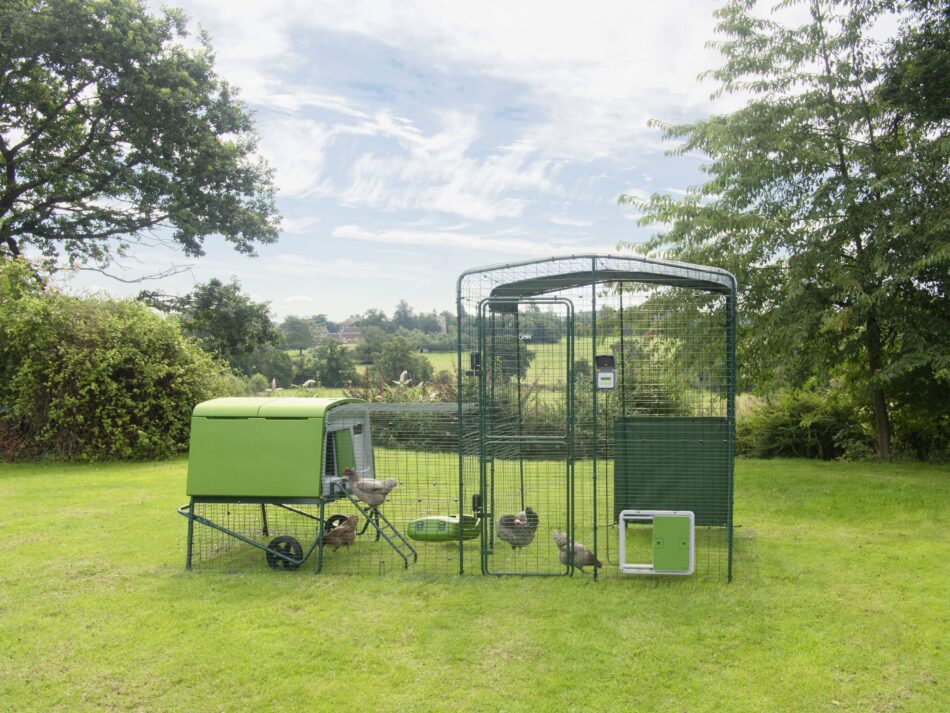
This entry was posted in Chickens

Avian flu is a headline that is grabbing the attention of American chicken-keepers. Commercial poultry farms have been aware of this virus for some time now, but backyard and small-flock raisers are beginning to wonder if they should take precautions. Is avian flu a serious threat to pet chickens?
It’s true that millions of chickens have been infected with this disease in 2022 alone. But while the headlines may seem bleak, there is a lot of misinformation out there, so choose your sources carefully. Take courage – the threat avian flu poses to backyard chicken flocks can be greatly minimized! With a few simple modifications and precautions, you can continue to enjoy caring for your chickens without dwelling on avian flu.
Chicken keepers need not stress during this time. Common sense, research from reliable sources, and a well developed plan will eliminate any doubt or fear when keeping chickens – during an avian flu outbreak or otherwise. With a deeper understanding of avian flu, you’ll be able to make more informed decisions on how to best protect your chickens from contracting the virus.
What is avian flu?
“Avian Flu”, also known as “bird flu”, are a group of avian viruses that actually date back to the early 1900s – though they wouldn’t be isolated as influenza viruses until the 1930s. Like most viruses, several different strains of bird flu have emerged over the years. Most strains of bird flu are denoted with LPAI (low pathogenic avian influenza), with the majority of birds showing little to no symptoms and having low transmission rates.
The natural hosts for avian flu are aquatic species of birds such as gulls, ducks, and geese. Since these birds are migratory, avian flu is carried throughout the world during their flights. These hosts are usually asymptomatic, or experience very mild symptoms.
Avian flu infects birds of all species, but can also infect mammals – including humans. Thus far, there has been no evidence of human-to-human transmission of avian influenza, but historically there have been documented cases of mammal-to-human transmission.
The history of bird flu
The strain we are encountering today was first discovered in 1996, isolated from a goose in China. The virus’ official name became: H5N1 HPAI (highly pathogenic avian influenza). Unlike other strains of avian flu, H5N1 proved to be not only highly contagious, but also carried a high mortality rate for birds – particularly in poultry. By the end of 1997, millions of poultry lives were lost to the virus, and by 1998 the CDC had confirmed cases of bird-to-human transmission of the H5N1 Hong Kong avian flu.
Since its emergence, this strain of avian influenza has followed a pattern of laying somewhat dormant, only to re-emerge in another avian flu outbreak years later. H5N1 was first identified in the US during 2015 when it was isolated in a wild bird. During that outbreak, multiple strains of H5 avian flu viruses were in circulation.
H5N1 would not become the predominant strain of avian influenza in circulation until the end of 2021, making its US debut in January of 2022. H5N1 HPAI remains the predominant strain of avian influenza across the globe. The current outbreak has claimed millions of avian lives, and has driven up the cost of poultry products all over the world.
Current avian flu strain
The current avian flu outbreak in the US is from this same strain of avian influenza. Until January 2022, the US had not seen a true outbreak of H5N1 since 2016. While contracting avian flu is still considered rare in humans, millions of birds all across the US have been infected since the beginning of this year. There has only been 1 confirmed human case of avian flu in the US since H5N1’s re-emergence in 2022, and no human-to-human transmission has been reported. An easy-to-clean chicken coop will decrease human exposure to avian flu during routine coop management.
For more information, refer to the CDC’s official website for avian flu activity in the US.
Signs and symptoms of avian flu in chickens
LPAI (low pathogenic avian influenza) shows little to no symptoms in birds of all species. Some symptoms of LPAI typically involve:
However, H5N1 HPAI, the avian virus sweeping the globe currently, has much more serious symptoms and a much higher mortality rate. Migratory birds that carry the virus may be asymptomatic, but in domestic poultry such as chickens and turkeys, the symptoms are often quick to progress and as of now, nearly 100% fatal.
Symptoms of the H5N1 avian flu in chickens include:
- Discoloration and/or swelling of combs and wattles; they may appear “blotchy” or blue tinged
- Dark red discoloration of the feet
- Bloody nasal secretions
- Green diarrhea
- Sudden, unexplained death
Avian flu sometimes spreads through a flock so quickly that the only sign of infection is unexplained death. It is extremely important to remove any deceased chickens from the rest of the flock using PPE (personal protective equipment) – ideally latex gloves, an N95 mask, and a disposable covering for your clothes.
Contact your chickens’ veterinarian right away if you notice any of the above symptoms, or if you have reason to believe that a chicken has died from avian flu. Tests can be conducted to confirm infection.
How is avian flu spread?
H5N1 is spread through respiratory droplets, saliva, and in the feces of wild birds. Your chickens need to come into contact with these contaminants in order to become infected, so it’s important to have enclosed, easy to clean hen houses. While small backyard birds can in theory carry avian flu, it is most commonly carried by waterfowl such as wild ducks and geese. Since these birds are migratory, they are able to spread infections all over the US, not showing partiality between backyard flocks or commercial poultry farms.
Chickens and other poultry are flock animals, and can spread the virus to each other rapidly due to their nature. Since this variant of avian flu is highly pathogenic, it is also very contagious and can sweep through an entire flock in a matter of days.
The natural host for avian influenza is waterfowl, so exercise great caution if you also keep ducks, geese, swans, or other water-loving birds. Since they are carriers, many are asymptomatic or display minor symptoms. Waterfowl should be housed separately from chickens, with no contact between the two.
Treatment for avian flu
Currently, there is only supportive treatment for avian influenza viruses. Antibiotics may be given to prevent secondary infections, but are usually only used when treating LPAI viruses. HPAI viruses spread so fast and overwhelm a chicken’s immune system so quickly that there is little time for supportive therapy. Furthermore, H5N1 HPAI shows such a high mortality rate that supportive therapy is unsuccessful.
Currently, the US does not have an approved vaccine for H5N1 for use in chickens, but trials are underway to develop an effective poultry vaccine.
An ounce of prevention is worth a pound of cure
The best method of treating avian flu in your chickens is to prevent them from contracting it in the first place. Thankfully, there are many methods you can implement immediately to greatly mitigate the risk of your flock becoming infected with bird flu.
The first step should be to bring your flock in and confine them within a walk-in chicken run. Free-range chickens have the greatest risk of infection of avian flu. You should ensure that the wire of the run is small enough that wild birds cannot enter the run with your chickens.
Once you have a chicken run set up, you’ll want to take the following precautions:
- Cover the top of the run completely with a waterproof chicken run cover to protect against wild bird droppings or saliva.
- Limit human-visitors in the run, especially if they have outdoor birds of their own (the virus can be spread on the bottoms of their shoes).
- Exercise caution when visiting with other bird-keepers – bleach the bottom of your shoes and wash your clothes after handling or visiting other flocks.
You’ll also want to quarantine any new chickens for a minimum of 10 days before introducing them to the rest of your flock. Be sure to keep new chickens in an enclosed space with the same precautions taken for the rest of your flock so that they do not become infected during their quarantine period.
How Omlet can help protect your flock from avian flu
Whether you’re setting up a quarantine coop for new chickens, or wanting to increase protection for your existing flock, Omlet products offer the peace of mind all chicken-keepers need during this worrisome time.
A quality, easy to clean chicken tractor is essential when keeping chickens – not just during an avian flu outbreak, but for every day care as well! Covered chicken feeders offer additional protection from falling contaminants and shield against aerial purusings by wild birds passing over your chickens’ area. And while your chickens are in the safety of a walk in chicken run, boredom-busting toys such as the chicken Pendant Peck Toy, Chicken Swing or Freestanding Chicken Perch will keep their minds and bodies busy!
Avian flu is a serious illness, but with some extra caution and the right supplies, you’ll ensure your chickens are healthy and happy while this outbreak runs its course.
Can humans catch bird flu?
There have been documented cases of bird-to-human transmission of avian influenza, but it is considered rare. Since the reappearance of H5N1, only one confirmed case of avian flu in a human has been reported in the US. The individual was working directly with a commercial culling of poultry suspected to have H5N1 avian flu. Their symptoms were mild, and they have since fully recovered.
Since poultry spread the virus through their saliva, nasal secretions, and feces, humans have to come in close contact with these substances in order to become infected. An individual can become infected when the avian flu virus enters in through their nose, eyes, or mouth.
Wearing gloves and masks when interacting with sick chickens greatly reduces your risk of contracting avian flu. Wash your hands thoroughly after handling or cleaning up after your chickens, and wash your clothes promptly after handling any ill birds.
Can other pets catch bird flu?
Other mammals have had confirmed H5N1 infections. In the US, avian flu has been found in various animals such as wild foxes, bobcats, coyotes, raccoons and skunks. Domestic pets can also contract H5N1. During the 2016 avian flu outbreak, a veterinarian in New York contracted bird flu from a cat that had been infected.
To protect your other pets from avian flu, be sure to keep them away from wildlife. Healthy wild animals will run from dogs and cats, but those that are ill often have altered mental states or are too weak to run from your pet. Never allow your pet to approach a dead wild animal. If your pet comes in contact with a sick or dead wild animal or poultry, call your veterinarian to discuss next steps.
Wash your pet’s feet with soap and water after hiking or walks in areas where birds frequent. Consider keeping your pet on a leash during walks to reduce exposure potential. Monitor your pets for any unusual symptoms, and report any findings to your veterinarian promptly.
Omlet petcare
Caring for chickens during an outbreak of avian flu can be concerning, but with the proper measures in place it doesn’t have to be stressful. The more preventative actions you take, the less likely it will be for your flock to become infected with avian influenza.
Some other practical ideas to stave off avian flu include:
With planning and preparation, you’ll be able to enjoy caring for your chickens in spite of an outbreak of bird flu.
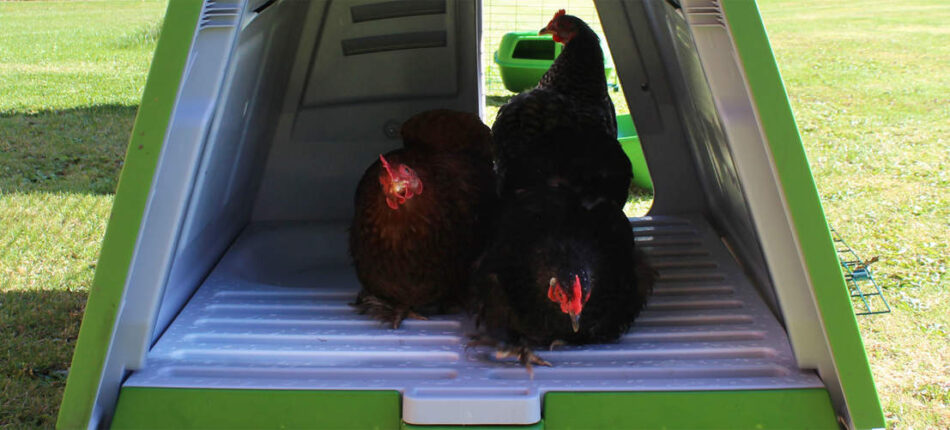
This entry was posted in Chickens
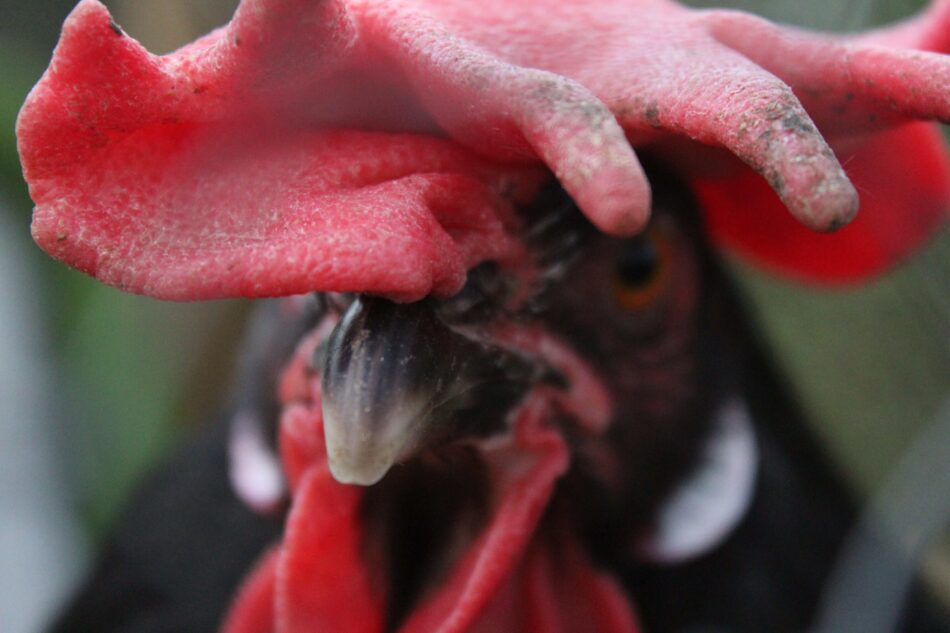
Avian flu, also known as H5N1 HPAI, has spread to over 40 states over the course of 2022. Beginning in November 2022, the US began seeing record numbers for H5N1 cases among poultry. With bird flu making so many headlines, chicken keepers want to know what they can do to protect their flocks, and what signs and symptoms of avian flu to watch out for.
Symptoms of avian flu in chickens can mimic various other illnesses, so it’s important to familiarize yourself with the most common signs of avian influenza in your flock-members. If you haven’t already, it’s more important than ever to be established with a veterinarian that treats chickens. Only a veterinarian with diagnostic tools can differentiate bird flu from other diseases in chickens.
Along with veterinary care, your chickens need a large chicken coop with a covered run. You’ll want to keep your chickens in an enclosed area that can be optimized for their health. Keeping your chickens close to home will also help you monitor for the signs and symptoms of avian flu.
What is avian flu?
Before becoming acquainted with the signs and symptoms of avian flu, it’s important to understand what type of virus it is. Avian flu, or avian influenza, has a long history in the US– dating back to the early 1900s. Later, the disease formerly known as “fowl plague” would be isolated as an influenza virus.
As with all viruses, avian influenza has many different strains. Virologists identify and label different types of influenza viruses with a letter and number sequence, and in the case of avian influenza, a suffix denoting whether it is low-pathogenic or highly pathogenic. The strain currently in circulation around the globe is H5N1 (the specific strain) HPAI (highly pathogenic avian influenza). This particular variant of avian influenza was first seen in China during the late 1990s. Thankfully, H5N1 HPAI prefers birds for a host, so while human cases of this virus have been documented, it’s very rare. Furthermore, there have been no known cases of human-human transmission of avian influenza.
Unfortunately for chickens, H5N1 HPAI is particularly aggressive in poultry. The hosts carrying the virus (wild aquatic birds such as gulls, ducks, and geese) exhibit little to no symptoms, but are able to spread the virus through their nasal secretions, saliva, and feces. And, since the vectors for avian flu are migratory birds, avian influenza has been spread all over the world throughout the course of the year.
This is why covered chicken runs are one of the best defenses against avian influenza, as the birds carrying the disease are shedding the virus as they fly over. It’s also important to have your hens’ food in covered chicken feeders to not draw attention from birds passing through, and to reduce the amount of falling debris that could contaminate their meals.
Signs and symptoms of avian flu in chickens
Avian flu can present with the same symptoms as many other chicken diseases, so it’s important to know what specific signs to look for. LPAI (low pathogenic avian influenza) viruses can show similar symptoms to HPAI viruses, but are usually much less lethal to poultry in particular. While H5N1 HPAI is the main strain circulating in the US currently, it is possible that other strains of avian flu could infect a backyard chicken flock.
Common LPAI symptoms include:
- Sinusitis (nasal inflammation and congestion)
- Coughing
- Sneezing
- Discharge from the nose or eyes
- Deformed or difficulty laying eggs
Chickens can survive LPAI viruses with supportive care. HPAI virus symptoms can manifest as any of the LPAI symptoms, usually accompanied by:
- Discoloration or swelling in the face, legs, and feet
- Discolored wattles or combs
- Blood-tinged discharge from the nose or eyes
- Greenish diarrhea
Most often, H5N1 HPAI causes sudden and severe disease in chickens, and sudden death may be the first and only sign of illness. Chickens that survive initial infection often exhibit central nervous system symptoms such as incoordination or partial paralysis.
What to do if you think your chickens have avian flu
If you suspect your flock has contracted avian influenza, contact your veterinarian right away. Make note of symptoms, when they started, and how many chickens are affected. Depending on the information provided, your veterinarian may ask you to contact your state’s animal health official, or may contact them directly to discuss next steps.
PPE (personal protective equipment) should be part of every chicken-keepers first-aid kit, and should be worn when handling any ill chickens. Gloves and masks protect you from potential infection, but also helps limit the spread among your other chickens.
If possible, isolate sick chickens far away from your main coop and run. Keep a container of bleach outside of the quarantine run and clean the bottoms of your shoes as soon as you finish caring for ill chickens. Dispose of used gloves and masks promptly, and wash your hands with soap and water. Remove and wash all clothing that comes into contact with sick chickens as soon as possible.
Prognosis of avian flu in chickens
Unfortunately, H5N1 HPAI carries nearly a 100% mortality rate for chickens. This particular variant has even been causing symptomatic illness and death in wild birds that act as its host. Supportive therapy is the only treatment for avian influenza, but shows little success since H5N1 causes such severe and rapid illness.
There is not currently an approved vaccine in the US for H5N1 HPAI in chickens, but trials are underway to produce an effective and practical vaccine. Antiviral treatment is not currently recommended. With so little options, prevention remains the best treatment for avian flu.
How to prevent avian flu in chickens
The USDA recommends these methods for preventing avian flu in chickens:
- Restrict access to your property and your flock to both humans and animals
- Clean and regularly disinfect anything that comes into contact with your chickens
- If visiting another site with birds of any kind, thoroughly clean and disinfect any equipment that was used before bringing it home
- Don’t borrow lawn and garden equipment, poultry supplies, or other outdoor tools from other bird-keepers
- Know the warning signs and symptoms of avian flu
- Report chicken illness to your local veterinarian, or to your state’s animal health official
Create a barrier around the perimeter of your chicken run and coop with chicken fencing to prevent visits by curious animals – or humans! Make sure to have a well ventilated, easy to clean chicken coop attached to a walk in chicken run that is fully covered across the top. This will not only give your chickens a safe space to enjoy their time, but will also give you ease of access to clean and care for your hens.
What products to use against avian flu
An easy to clean chicken coop, walk in chicken run, and chicken run covers are necessities for keeping your chickens protected from avian flu, but there are number of other products that make caring for chickens during an avian flu outbreak easier and more enjoyable – both for you, and your flock!
A walk in chicken run porch addition is a perfect space to keep your PPE and cleaning essentials close by when entering and exiting your chickens’ run. Keep a box of disposable gloves, some masks, a spray bottle of disinfectant for the bottoms of your shoes, hand sanitizer, and trash bags in a bucket inside of the porch addition for easy access.
Chickens that are accustomed to free-ranging can experience boredom when first being “cooped up.” Offer chicken toys to encourage foraging and other natural activities to help pass the time. A freestanding chicken perch is a favorite among flocks, or design your own perching spaces with a chicken perch tree. The more (covered) space and activities you can give your hens, the healthier and happier they will be!

How Omlet can help
Our designs for chicken products have always had the wellbeing of both pets and their people in mind. The global spread of avian influenza didn’t change our vision or designs, but it did illuminate how an “ounce of prevention is worth a pound of cure” in the current climate for chickens. Omlet customers have had to make very few changes for their chickens in light of current events because our products were invented to withstand the elements and circumstances that chicken-keepers find themselves in. By providing your chickens with the best products year-round, you’ll be ready for whatever the years bring!
See how a chicken setup from Omlet can bring you and your chickens peace of mind in any season. Avian flu doesn’t show partiality to commercial poultry farms or backyard flocks of chickens, but by staying informed, prepared, and educated, you can continue to foster the bond between you and your chickens without the fear of avian flu.
This entry was posted in Chickens

Around the 1930s, battery cages, or small wire frame cages, were introduced as a way to increase egg production from hens on an industrial scale. Female chickens are placed in these cages from the time they hatch until full egg-laying maturity, which is typically considered 18 months.
While many countries have banned or are phasing out the use of battery cages, there are still many countries, including the U.S., where they remain legal. Because ex-battery hens have a lower egg production, many groups look to rescue them to provide a new home for these still full-of-life (and eggs) birds!
Most ex-battery hens require a little bit more attention and care during the first few months as they have to adjust to a new (and much better) life than what they previously knew. But just like any animal rescue, with some patience and extra love, they will quickly settle into their new routine and enjoyment of life. Here is how you can create the perfect setup for your ex-battery hens.
The Omlet Eglu Cube Chicken Coop
Ex-battery hens only know the confines of a small cage for their entire life until rehomed. So when creating a new space for them, consider their immediate needs of security, safety, and exploration. The Omlet Eglu Cube Chicken Coop is the perfect choice as it not only offers all of that, but is also super easy to assemble, carefully designed, and virtually maintenance-free.
In Rosie’s Chicken Keeping Adventure blog series, she shared her story of being a first-time owner of ex-battery hens. After rescuing 5 ex-caged hens of her own, Rosie decided on the Eglu Cube Chicken Coop as the new home for her flock because of the peace of mind it provided. Here are some of the features that made this product priceless for her hens, as well as herself.
- Predator resistant: Unlike free-range hens who have known life outside of a cage, ex-battery hens take a little more time adjusting to their new, more spacious, surroundings. As a result, it’s important that for whatever chicken coop you decide on, it is constructed with security and strength to keep out unwanted visitors.
The Eglu Cube is made with durable and predator-resistant hard plastic which is placed on a heavy-duty steel frame. Eglu Coops and runs have been keeping hens all across the globe safe for over 15 years and your ex-battery hens will be no exception.
- Plenty of space: Imagine living in a tiny studio apartment for your whole life only to be moved to a luxurious and spacious mansion….it’s a similar feeling for ex-battery hens who are rehomed to an Eglu Cube! At Omlet, our goal is to make chicken keeping simple and fun with practicality and efficiency in mind. Plus, we know just how important space and exploration is to chickens.
The run that comes with the Eglu Cube is expertly designed to create a full on henertaining playground for your chickens. And thanks to its modular design, you can very easily expand your run and walk-in chicken run that allow you to grow with your flock.
- Private nesting box: Battery-caged hens are stripped of many animal privileges, not the least of which is the ability to nest, or lay eggs, in private. Nesting is a natural instinct for chickens and something that ex-battery hens will quickly embrace once rehomed in an Eglu Cube.
The Eglu Cube’s private nesting box comfortably fits up to 3 egg-laying hens at a time. Collecting fresh eggs from your coop is definitely one of the greatest perks of being a chicken keeper, but for ex-battery hens, it’s literally a new leash on life that they are given with this space.
More Omlet chicken essentials
Once your ex-battery hens have adjusted to their new life in their Eglu Cube home, you can really start to customize their space. We have endless options for you to create the ultimate hen home and we know first-hand that ex-battery hens will love them all.
Omlet Chicken Fencing: No matter the size of your backyard, you can still increase the exploring space for your hens. Chicken fencing is the perfect way to allow your chickens free roam of the yard with risk of escape. Our chicken fencing is not only easy to install with a tangle-free design, but the dark color blends in neatly with your backyard.
Chicken PoleTree: Now the fun begins! Our fully customizable PoleTree is truly any chicken’s dream. Create a fun and engaging communal playground for your entire flock as your hens enjoy the stimulation and ability to check out new heights. You can install the tree in any walk-in chicken enclosure and know that it is sturdy and strong to hold several chickens at once. And don’t forget to add a chicken swing so your feathered friends can truly make the most of their new lifestyle.
Automatic Chicken Coop Door: Our priority with our chicken products is safety with simplicity and that is precisely why we created the Universal Automatic Chicken Coop Door. Compatible with any wooden coop as well as the Eglu Cube, this is the safest and most convenient way to let your chickens in and out of the coop. Battery-powered with the option to operate on a timer or sensor, this door will not only guarantee all hens are home safe at night, but it will also keep your chickens protected from any weather elements with the added insulation of a closed door – even if you’re not yet home.
How you can help ex-battery hens
The number one way you can help ex-battery hens is by adopting them and giving them a new home of their own. But how do you do that? There are several non-profit organizations in the U.S. that intervene at the commercial farming level to advocate for these hens and give them a second chance at life. Their mission is simple – rescue and rehome ex-battery hens.
Organizations such as The Humane Society of the United States and The Humane League in California are just a few examples of places you can check out to learn more about how you can help these animals. And if you are interested in having a flock of your own, check out this website to search by state and local areas:
http://www.adoptabirdnetwork.com/shelters-list.php
There is no better reward than to give an ex-battery hen a new home – for you and your new feathered friend! With an easy set-up like the Omlet Eglu Cube, your hens will live out the rest of their days in peace, comfort, and joy. And as their chicken keeper, you will wonder how you ever lived without them in the first place.
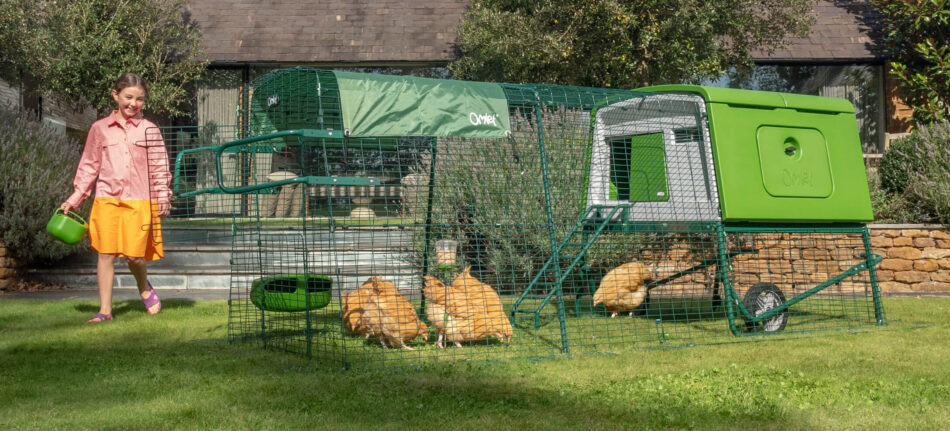
This entry was posted in Chickens
Chickens are a pet that give a return on your investment. Not just through a rewarding emotional bond that is experienced between pet and owner (though certainly that too), but through tangible goods: delicious, nutritious, and gorgeous eggs. The nutritional makeup of an egg alone is amazing, but you can also analyze your chickens’ eggs to get a glimpse into their overall health. What do your hens’ eggs say about their health? From laying frequency, egg size, shape, color, and texture — here’s what your daily gathering can tell you about your flock.
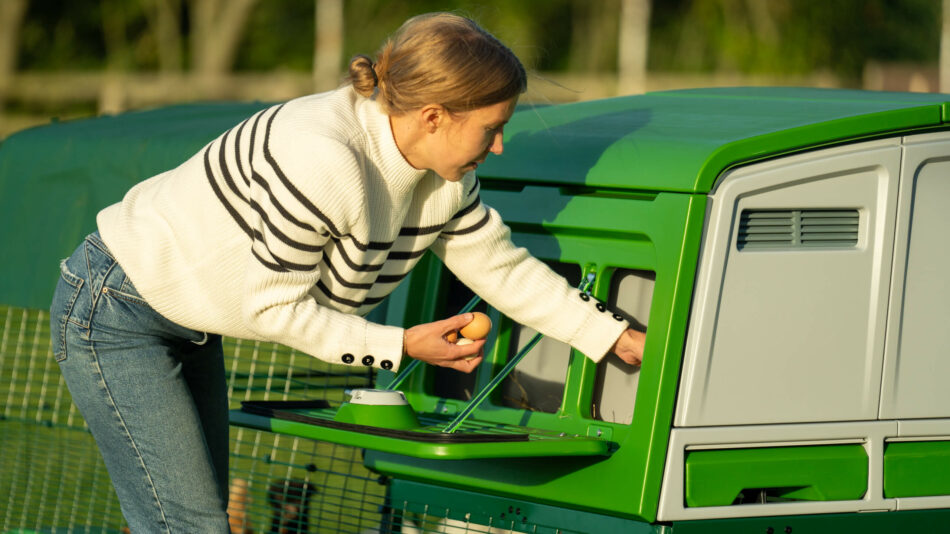
Nutritional value of eggs
Healthy hens lay healthy eggs, and it’s hard to beat their nutritional value. On average, one chicken egg contains just 75 calories, but 5 grams of protein. Along with milk, eggs hold the “gold standard” for biological protein value. Eggs also contain vitamins and minerals essential to human health. And they’re versatile too — there are so many different ways to enjoy eggs, either on their own or as part of a recipe. When your hens are laying healthy looking eggs on the regular, it means they’re receiving proper nutrition and feel safe in the nesting area of their chicken coop.
When you aren’t collecting these nutritional offerings as often as usual, or if your hens’ eggs begin to look or feel unusual, there may be underlying issues at play. From illness to stress, here are some ways your flock’s eggs can hint at a health concern.
Change in egg laying frequency
How often do hens lay eggs? The answer is a bit more complex than the common notion of “an egg a day,” and many factors are taken into account when determining what is normal egg production for a hen. Breed, age, health, and time of year all affect how many eggs chickens lay.
Among the many different chicken breeds that are considered good layers (those that can lay upwards of 300 eggs per year), some well known egg producers include:
Ornamental and smaller chicken breeds lay less frequently, with some only laying a few eggs each month.
Hens that are not feeling well, or are malnourished will lay less frequently. Flock discord, inadequate nutrition, and overcrowding are a handful of stressors that can take a toll on egg production. Make sure your hens have access to clean water and quality layer pellets at all times to ensure they’re getting the calories and nourishment they need. Adding scratch grains, chicken treats, and healthy kitchen scraps or safe foods from the garden to their diet will also give hens a nutritional boost.
Hens will inevitably lay less, or stop laying eggs altogether in the winter. A hen’s ovulation cycle is based on daylight hours, so once the days shorten, you can expect egg production to slow down. This is a hen’s natural reaction to the changing seasons as they prepare to reallocate energy to keep warm instead of laying eggs. Your hens will resume a normal laying schedule closer to spring, as days grow longer.
Molting season
Another annual reason for a decrease in egg production is a process called “molting.” Molting is the process of shedding old feathers and regrowing new ones to replace them. This process also occurs in preparation for winter – so as the days grow shorter, your hens will begin to lose their dingy feathers in favor of new, more dense feathers to keep them warm. The result is a beautiful, vibrant new outfit of feathers for your hens – but less eggs for you to gather. Molting takes a lot of energy, so expect your chickens to be on “lay-cation” for 8-16 weeks. Helping your hens through their molt will better prepare your flock for their annual feather-renewal.
Eggs of a different color
Did you know that chickens lay eggs in several different colors? You’ve probably seen white and brown eggs, but some chickens can lay eggs in shades of green, blue, and even pink. So, what causes such a variety of colors?
Genetics determine what color eggs a hen will lay. Some breeds of chickens have a standard color you can expect from them. For example, you can count on Leghorns to lay white eggs, Orpingtons lay brown eggs, and Ameraucanas lay blue eggs. But different shades such as olive are the result of a hybrid hen – a hen bred from a combination of blue and brown egg genes. For example, if you bred an Orpington (brown egg genetics) rooster with an Ameraucana (blue egg genetics) hen, the result would be an “olive egger” hen that would lay green eggs. Egg color should be consistent with the hen laying them, and different colored eggs are not a cause for concern unless a hen suddenly starts laying a different shade from what is normal for them.
All eggs begin with a white shell, but the hen laying the egg adds a pigment to them as they make their way to be laid. This pigment only colors the shell, and does not penetrate the membrane.
Pro tip: you can get an idea of the color eggs a hen lays by looking at their earlobes. Hens with white earlobes will lay white eggs, and hens with red earlobes will lay brown eggs. This technique is not as accurate for pigmented eggs (blue, green or pink), as hybrid-chickens will have a variety of colors to their earlobes. Still, it’s fun to try this prediction-test with your flock.
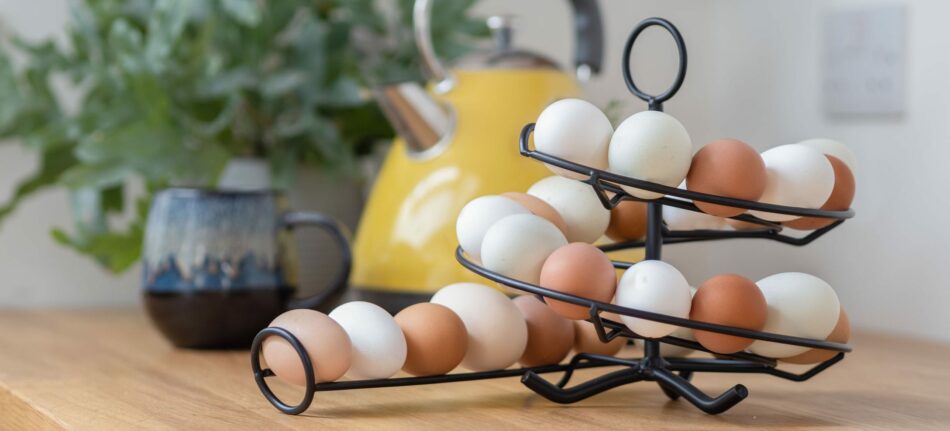
Double yolks
In a rare, but completely normal phenomenon, chickens can lay eggs with two yolks inside. If fertilized and incubated or kept under a broody hen, double-yolked eggs can hatch twin chicks – but it’s more common for only one embryo to fully develop.
If you crack one of your chickens’ eggs and start seeing double, it’s the result of the hen releasing two yolks at the same time during ovulation — which then become encapsulated within one shell. It’s more common for newly-matured hens to lay double-yolked eggs, as their bodies are adjusting to ovulation. Laying eggs with two yolks can also be genetic, and hens may continue to do so for the duration of their egg-laying career.
Thin shell, or no shell at all
Have you ever collected eggs, only to find yourself flabbergasted by a squishy egg? Soft-shelled eggs feel like partially filled water balloons and can be very disconcerting to find in the nesting box. These strange, spongy eggs are actually laid without the presence of the shell; only the membrane. This most often occurs with high-producing hens, when their bodies simply cannot keep up with yolk production. Oftentimes they will lay a fully-formed egg, then lay a shell-less egg a few hours later.
The other most common reason for eggs having thin or missing shells is inadequate calcium in their diet. Warning signs leading up to shell-less eggs can be thinner shells, so take note if your hens’ eggs are suddenly much easier to crack, or if you find broken eggs in the nesting box. A lot of calcium is required to “fully clothe” a yolk, so be sure to feed quality layer pellets that contain added calcium. If you notice thinner shells or “naked” eggs, supplement your hens’ feed with crushed oyster shells or other chicken calcium supplements. You can also save egg shells after cracking them to crush or grind up and sprinkle on top of your hens’ feed. Be sure not to offer shells that have not been broken down into smaller pieces, as chickens can acquire a taste for eggs and will actually eat them straight out of the nesting box.
Boost your hens’ shell-producing ability with chicken supplements to ensure they have all of the vitamins and minerals they need. As an added bonus, supplements such as omega-3 fed to your chickens pass through to their eggs– and then to you when you eat them.
Looks can be deceiving
Sometimes an egg might look a little off, but it may be hard to place why. These common sights are usually no cause for concern unless they become the new normal.
Why is there blood on my chicken’s egg?
While it may look concerning, blood smears on an eggshell usually indicate that it came from a new layer (pullet). This issue should resolve on its own after the first few weeks of laying.
Why are my hen’s eggs long and skinny?
Also more common in pullets just starting to lay, eggs can sometimes take on an awkward shape or appearance. Young hens will often start laying smaller, elongated eggs that look almost pointed. If elongated eggs appear suddenly and regularly in mature hens, notify your veterinarian, as this could indicate illness.
Why do my chickens’ eggs have bumps, divots or ridges?
The texture of eggs is an excellent sign of potential nutritional deficiencies or stress in your flock. Any hens’ consistently laying eggs that do not have a round, smooth shell, are experiencing either stress or malnutrition. Make sure your chickens’ feed has adequate levels of protein, calcium, and vitamins and minerals. Overcrowding is often a source of stress for chickens, so give them plenty of room in a walk in chicken run or an area of chicken fencing during the day, and adequate space in their chicken coop at night.
Why is there a chalky film on my hens’ eggs?
An abundance of calcium in a flock’s diet can cause eggs to be laid with a chalky or waxy appearance. Brown eggs may take on a pink hue from this excess calcium, or you may see flecks of white on darker colored eggs. To correct this, scale back on calcium supplements until the eggs take on a normal appearance once again. If the film persists but only with one or two hens, it’s more likely that you have a couple of hens that produce a thicker bloom (cuticle) layer than others. In this case, the waxy film is perfectly normal, and even beneficial.
Even though they may not look as appealing as “normal” eggs, most unusual looking eggs are safe to eat. Most of the time deformities lie within the shell only, with the inside of the egg remaining unaffected. Any eggs that have sustained damage to their shell should be discarded, as bacteria will have had the chance to enter through the compromised shell.
Chicken checks
Check-in with your hens by doing regular chicken health checks to make sure everyone is in tip-top shape. Look for any new or unusual signs or symptoms in your chickens during this health check. It’s also a good idea to have an extra Eglu Go Chicken Coop setup for quarantining sick or new flock members.
Unusual eggs can sometimes point to illness. If you notice your chickens having symptoms accompanying irregular egg laying, or the prolonged presence of abnormal-looking eggs, it’s time to contact your veterinarian.
Omlet and your hens’ health
Eggs can tell you a lot about your hens’ health — but so can their appearance and activity level. That’s why we’ve made it easier and more enjoyable than ever to keep your flock fit and healthy. Our extra large chicken coops give everyone in your flock plenty of space to lay and roost, and our walk in chicken runs can be expanded to any dimension of your choosing — giving you plenty of space to spend time with them. Round out your setup with a customizable PoleTree Chicken Perch, and your hens will have the ideal space to keep them healthy and happy for years to come. With our ingeniously designed products, you’ll always know what your flock is up to, and that every part of their home has been carefully crafted for their health and happiness.
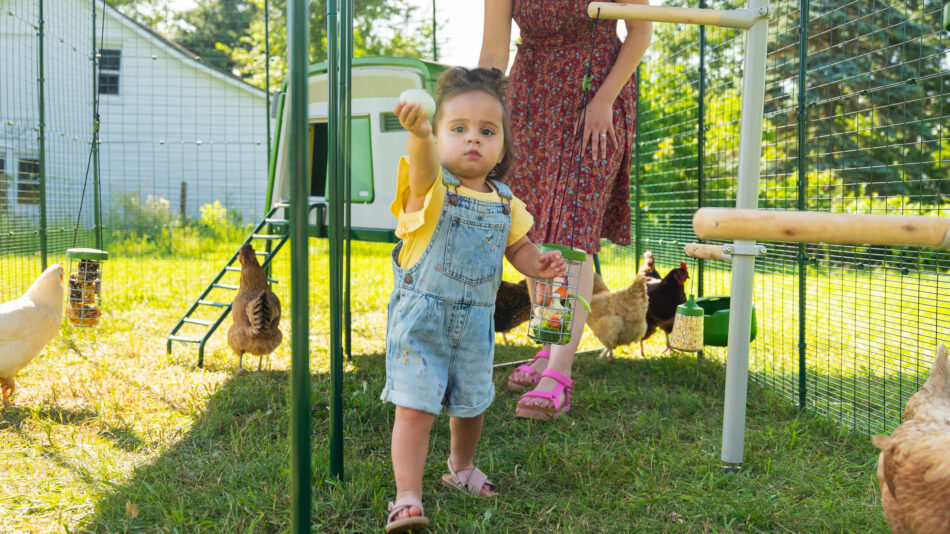

This entry was posted in Chickens
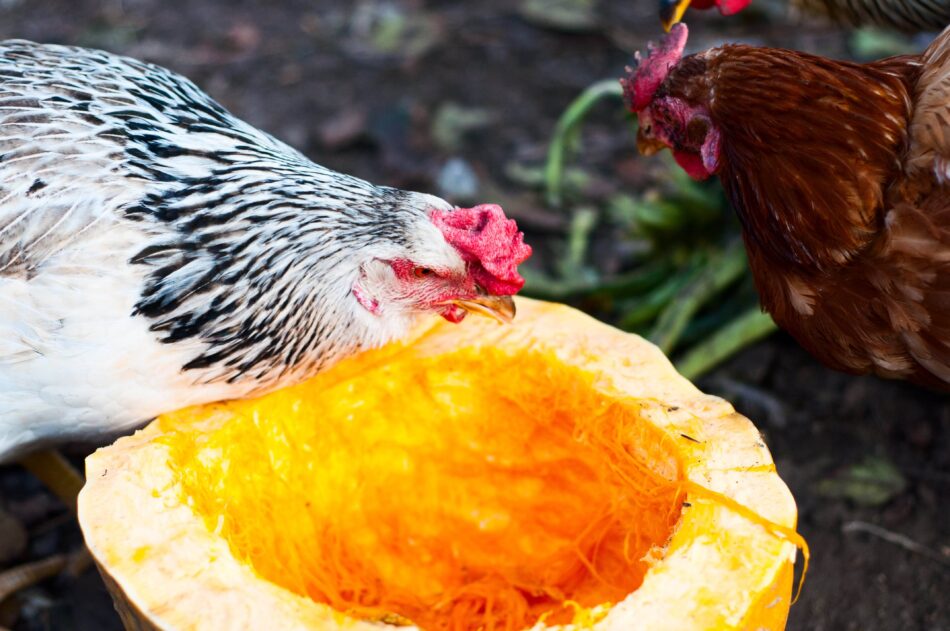
Thanksgiving is a holiday for reflection, appreciation, celebration – and food! Millions of homes will set out a spread for their families to partake of on Thanksgiving Day. In fact, Americans typically consume around 3,000 calories in their one Thanksgiving meal!
And speaking of calories, did you know your chickens need more during the colder months? Your chickens will consume extra calories not just in one holiday-meal sitting, but all season long! A combination of molting cycles, cold weather, and less daylight drives chickens to eat more during the day in preparation for long, chilly nights. Sharing some pantry staples with your flock will give them the extra support they need this season.
Sharing is at the heart of Thanksgiving, and with extensive human-menus, you’re sure to find foods to create a feast for your flock as well! Several holiday food staples can be safely offered to your chickens for a Thanksgiving meal of their own. Serve it up in a creative way, and your chickens will officially be part of the holiday festivities!
Special winter-weather feeding considerations
As the days grow shorter, your chickens will start their annual molting cycle. They’ll shed their drab summer-worn feathers and don new, more dense feathers that will act as a winter coat. This stunning change requires lots of energy – so even though your hens won’t be laying eggs while they molt, they will need the extra calories to help grow new feathers and support their metabolisms.
The cold weather will also ramp-up your chickens’ appetites. Extra food means extra energy expenditure to digest, which warms up their bodies. So what are some of the best treats to give chickens in the winter? Some ideas include:
- Warm oatmeal
- Leftover pumpkins (whole or pureed)
- Carbohydrates such as cooked pasta or sweet potatoes
- Suet blocks (DIY or store bought in the wild bird section)
Consider giving your chickens supplements to support their immune systems and energy in addition to warm, energizing treats. You can also offer alfalfa hay in your chickens’ run as a supplement to their regular diet. Alfalfa hay has many nutritional benefits, and your chickens will spend hours scratching and pecking through the fiber and protein-rich stems and leaves.
Turkey-day treats for chickens
With so many delectable dishes on the menu for Thanksgiving, the possibilities to share with your feathered-family members are many! When preparing your holiday meal, set aside some trimmings or extra ingredients to feed to your chickens. Some holiday-meal ingredients to share with your chickens include:
- Cranberries (dried or fresh)
- Raisins
- Celery, carrots, squash, or pumpkin
- Sweet potatoes and yams
- Nuts (shelled) and seeds
You can also make suet cakes for your chickens as a special holiday treat. Many recipes can be found online, and you can customize your creations in molds to shape them! Suet is lard or tallow-based with various mix-ins such as nuts, seeds, whole grains, and dried, unsweetened fruit.
As with all treats, these should be fed in moderation, and should not be a replacement for their regular diet of laying pellets and scratch grains!
Fit for your table, but not for your chickens
While many Thanksgiving meal components are fine to feed your chickens, there are some foods that are important to avoid giving to your flock. These include:
- Chocolate
- Raw onions or garlic (or large amounts of either cooked)
- Raw potatoes or peels (raw sweet potatoes are fine)
- Citrus fruits
- Uncooked beans or rice
- Anything high in salt or fat
As tempting as it may be to give your chickens a slice of pie or leftover rolls, it’s much better to offer nutritional alternatives like suet cakes or vegetables. Sugary or fatty foods can cause digestive upset in hens, which is particularly detrimental when weather conditions are less than favorable!
Presentation matters
Chickens are very visual animals. They constantly scan their surroundings for threats, look for tiny movements from insects they’re seeking, and are known to enjoy bright, bold colors. Putting their Thanksgiving treats in a Caddi chicken treat holder is a great way to catch their attention through presentation. As an added plus, you can bring the Caddi chicken treat holder with you to the kitchen during meal-prep and place any chicken-safe goodies inside for safe keeping. Once the chicken treat holder is full, hang it in your hen’s run and watch their gratitude radiate!
You can also place a chicken peck toy in their run with either fresh corn, seeds, and shelled nuts, or with their usual scratch grains for added enrichment. Your chickens will be extra thankful when you combine food with visual appeal!
Thankful for our flocks
We’re thankful for our chickens, and they show their gratitude in the only way they know how – in providing delicious eggs! Some hens have personalities that rival a dog’s in affection or loyalty, while others are content to regard their owners from a distance. But no matter what their personalities are, chickens are always thankful to be together with their flock – which includes you!
By giving them quality chicken coops, runs, and accessories, you can ensure your hens are getting everything they need to be healthy, safe, and happy not just this holiday season, but all year long. And don’t forget to thank them for those eggs you’ll be cracking into your Thanksgiving dishes!
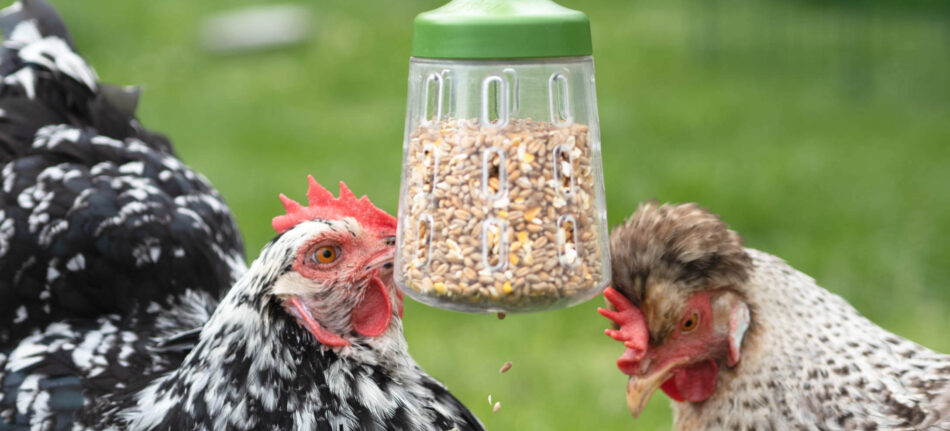
This entry was posted in Chickens
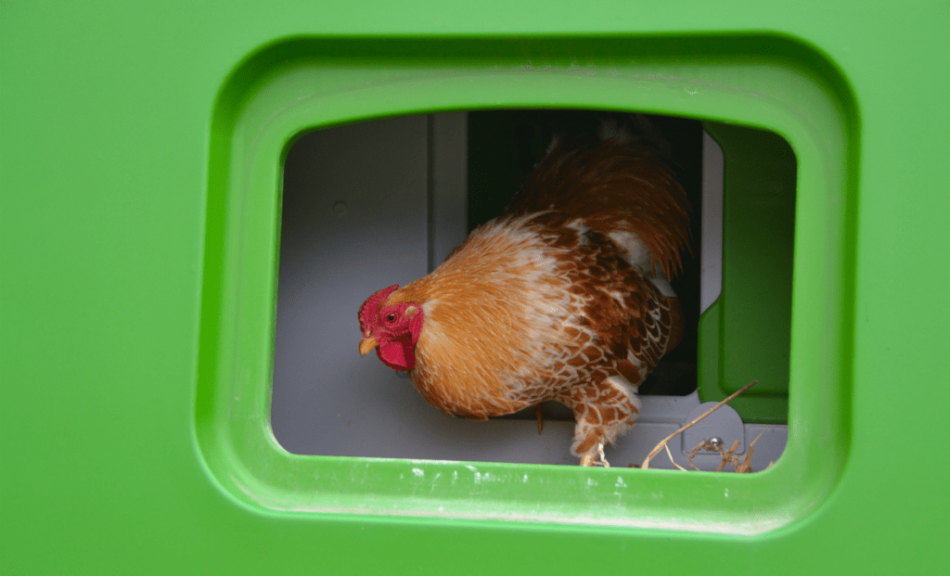
You’ve seen to your hens’ every need for months. Their coop is clean, they’re well fed (treats included!), entertained, and have finally shed their adolescent feathers and donned laying-age hen skirts. At last, your efforts are finally rewarded in a clutch of farm fresh eggs.
Your hands, basket, or apron (if you’re feeling fancy) are now full of those smooth cackleberries, and ready to go…where? You could keep them in store-bought containers, custom ordered cartons, or displayed on a countertop egg skelter. But where is the best place to keep them after that? Should you wash them? Leave them be?
From backyard flocks to large commercial operations, all chicken-keepers need to research the best methods for keeping fresh eggs, well, fresh!
Methods and misconceptions
Here are some of the most common methods of keeping freshly-laid eggs:
- Unwashed, on the countertop
- Washed, then refrigerated
- Sealed for long-term storage in an air-tight container at room temperature
There are some common misconceptions regarding these methods and the freshness they are able to sustain. You might be thinking:
Who wouldn’t wash their eggs?! I love my chickens, but I don’t love their mess!
When I buy eggs at the store, they’re refrigerated – surely that’s the best method?
I don’t want to find a partially-formed chick when I crack a room-temperature egg!
Fortunately, there are easy (and even scientific!) answers that can put your mind at ease and help you decide where to keep those nutrient-packed eggs!
Eggs on display
Let’s start with the most common method for small-batch chicken egg gatherers:
Fresh, unwashed eggs kept on the countertop at room temperature.
It’s a common fear that keeping eggs at room temperature will allow a fertilized egg to continue developing into a chick. However, fertilized chicken eggs need to be kept around 100.5 degrees Fahrenheit, maintain a humidity level of 65-70%, and be turned several times a day for 21 days in order to develop! Unless your countertop meets these requirements (and therefore be the largest incubator in your state!), fertilized eggs will not develop unless they remain under a broody hen, or placed promptly in an egg incubator.
The importance of unwashed eggs being kept at room temperature however, cannot be understated. Why is this so important? When eggs are laid by a hen, they are bathed in a protective barrier of the hen’s natural flora, called the “bloom.” This good-bacteria keeps the embryo safe from external bad-bacteria while it develops. Eggs also have semipermeable shells, which allows nutrients in and out of the membrane to nourish a growing chick. If the bloom is removed by washing, good and bad bacteria are able to move freely into the egg.
So what does this mean for egg-keepers? Simply put: if you wash the eggs you gather, you remove the natural, hen-given barrier that not only keeps the egg fresh longer, but may even push harmful bacteria into the egg.
This doesn’t mean that eggs stored on the countertop need to be filthy! You may want to keep a designated (emphasis on designated!) toothbrush or rag to remove large debris from the egg. There are also DIY or store-bought varieties of egg wipes that will loosen caked on messes without compromising the integrity of the bloom. Just remember- if an egg comes in contact with water, the bloom is compromised!
An added bonus of keeping eggs on the countertop is the visual appeal. Egg skelters are one of the many ways to artfully display the fruits of your girls’ labor!
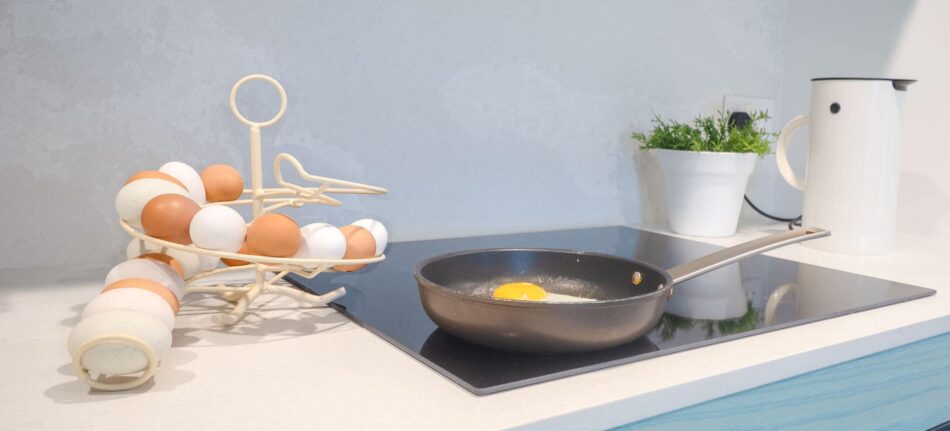
Refrigerated eggs
If you’re a casual egg-consumer, or saving up for some holiday baking, refrigerating your chicken’s eggs may be your best option. Eggs can go straight into the fridge from the nesting box, or they can be washed first.
Fresh eggs can be washed in store-bought or homemade solutions, or under warm, running water. The water needs to be warmer than the egg you’re washing, and needs to remain in motion so that eggs aren’t soaking in a dirty rinse- both of these factors reduce the chance of bacteria being pushed into the egg. Once washed, eggs can be patted dry and placed in the fridge. All washed eggs need to be stored in the refrigerator or eaten promptly!
Refrigerated eggs (washed or unwashed) will remain fresh longer than their room temperature counterparts – several weeks longer, in fact. But it’s important to note that once eggs are refrigerated, they need to stay that way! Just as store bought eggs need to be kept chilled, fresh eggs (especially washed eggs) will spoil much faster going from fridge to countertop.
Long-term preservation
The last storage method is for long-term storage. Really long term!
You can “water glass” your eggs.
Water glassing is the method in which our ancestors used long before refrigeration or other preservation techniques were used. This method is simple and effective, and can be beneficial when needing to store eggs over the “fussy” season when hens aren’t feeling particularly productive!
To water glass eggs, you’ll need:
- Unwashed, freshly gathered eggs
- An airtight storage container
- Pickling lime
- Distilled or natural spring water
Once sealed, “glassed” eggs will remain fresh for up to 18 months!
If this method seems intriguing, be sure to do some research on the ratios needed for each ingredient, depending on how many eggs you plan to store.
Quality control: egg-checks
No matter which method you employ in storing your farm-fresh eggs, it’s always a good idea to do freshness-checks on any eggs you’re about to consume. One of the easiest methods is to place an egg in a glass of water. If the egg sinks, it’s fresh. If it turns on end (standing up), it might not be the freshest, but should still be safe to eat. If it floats – toss it!
Eggs become filled with gasses as a by-product of aging. Egg whites lose their viscosity and become watery. These lighter, air-filled eggs will float when placed in water!
If you don’t want to float your eggs, you can easily check their freshness by cracking them into separate containers before adding them to your skillet or mixing bowl. This method is particularly helpful when children are the primary gatherers and may be bringing in older eggs, or after going on vacation. You’ll know a rotten egg when you crack one!
In summary
- Fresh eggs can be stored a variety of ways, depending on quantity and duration needed.
- Eggs kept in the fridge need to remain in the fridge.
- Do not wash room temperature eggs.
- Once rinsed or cleaned with a solution, eggs must be refrigerated or used promptly.
- Check the freshness of your eggs by floating them in water just before using them, or by cracking individual eggs into a bowl before adding to dishes.
There you have it! Three simple and effective ways of storing your hens’ edible artwork.
Drop a line or a picture below to show how you store your farm eggs!
Please note: if you are offering your farm fresh eggs for sale, be sure to check your state’s guidelines for selling eggs. Some states require that farm eggs be sold unwashed, while others require washing and refrigeration. Additionally, some states may require eggs be given a “grade” before being sold to notate freshness.
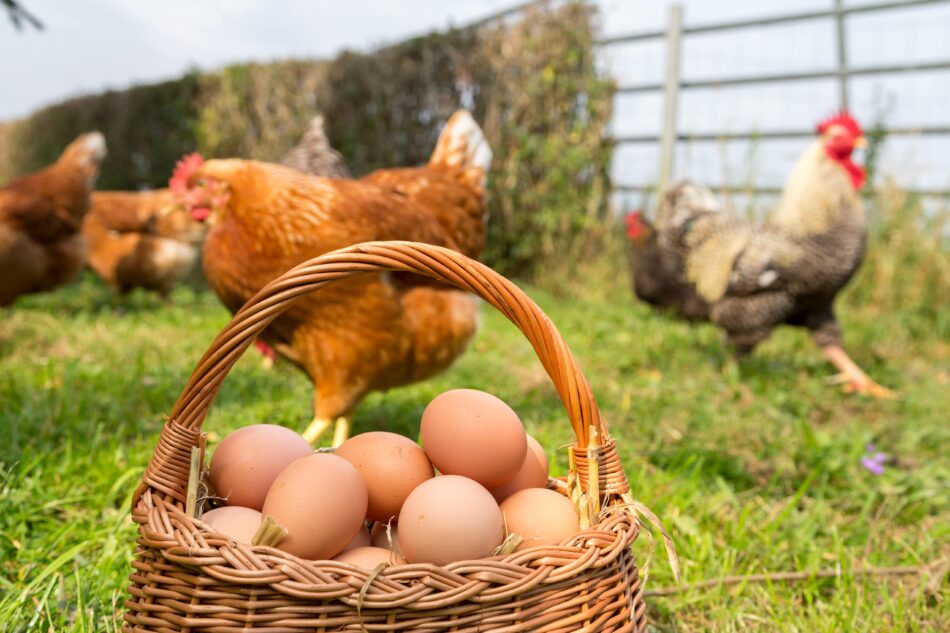
This entry was posted in Chickens
Did you know that chickens were domesticated thousands of years ago? Our favorite egg-laying friends have been part of farming practices since 2000-1500 BC! Long praised for their plumage, egg laying efficiency and ease of care, chickens are kept all over the world in backyards and barnyards alike.
But what else do chickens have to offer? What are the benefits of owning chickens?
Fresh eggs
It’s true that most people acquire chickens to have fresh eggs on a regular basis. Chickens have provided humans with delicious protein-packed cackleberries for centuries. In fact, different breeds of chickens have emerged over the years to enhance both egg production and egg composition. Through selective breeding, hens are capable of laying not only white eggs, but brown, blue, green, and even pink eggs!
Good laying hens can produce 5-6 eggs per week. They start laying when they are about 18 weeks old (although this can vary between breeds, with some breeds not reaching laying-age until 6 months), and will continue to lay eggs until they are 5 or 6 years old. A well-kept and fed backyard hen can lay up to 250 in the first year! Eggs start off small and elongated, but once a hen has some successful egg-laying-sessions under her belt, the eggs will be larger and more shapely. You can’t expect her to keep going at this rate though! Your hen will slowly taper off her egg production to about 80% in her second year, with a decrease of around 10% thereafter. That means if she layed 250 eggs her first year, the second year would yield around 200 eggs. Year three would yield around 175, and so forth.
Some of the best egg-producing breeds include: Rhode Island Reds, Plymouth Barred Rocks and Buff Orpingtons. If colorful eggs are what you seek, breeds such as Ameraucana Marans, Barred Rocks, and Welsummers. Some popular cross-breeds have been developed for egg coloration, and go by the common names of “Easter Eggers” or “Olive Eggers.”
Even chickens that are considered low-egg producers can still lay 2-4 eggs per week. As long as hens are happy and healthy, you’ll be provided with a steady stream of fresh eggs to enjoy!
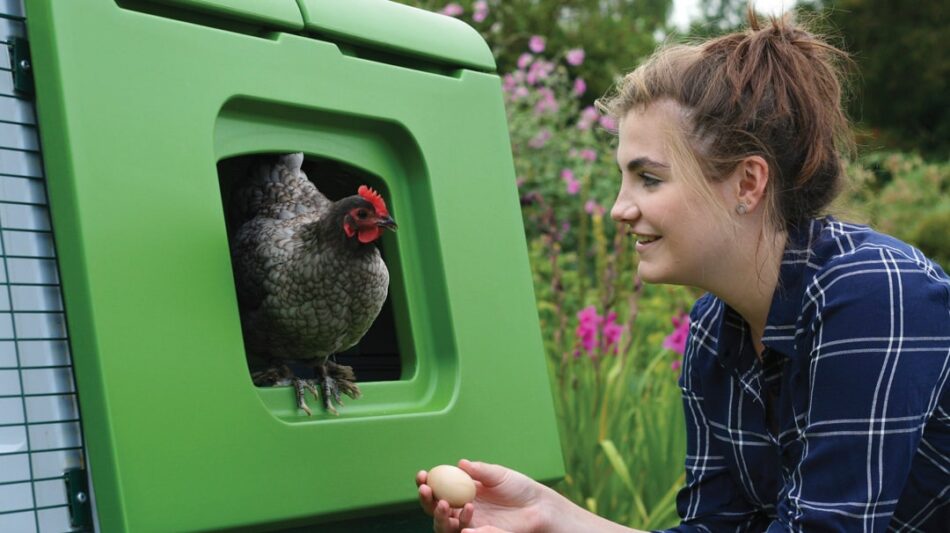
Pest control
Say goodbye to pests without calling the exterminator – just let your chickens take care of the creepy crawlies! Your flock will feast on just about every bug that plagues your yard. Ants, hookworms, moths, grasshoppers, ticks, centipedes, termites, spiders, and even scorpions are on the menu for chickens.
Insects are an excellent source of protein for your hens, and chasing bugs is enriching for them and entertaining for you! You’ll notice your chickens’ inner dinosaur (they are related, after all!) on display as they zoom around the yard after a wayward grasshopper or moth.
And if your human exterminator has already done an excellent job of ridding your property of insects? Grab a bag of dried mealworms as a treat or training tool. You can also visit your local pet store to purchase live insects for extra enrichment – simply release the insects into your chickens’ run and watch their instincts kick in!
Feathers
Yes, we said feathers! Eggs get the most attention, and while they are definitely fun to look at, chickens have other visually appealing products of their nature.
Chicken plumage comes in a wide array of beautiful colors and patterns. Along with regular feather-loss, chickens molt once a year, which means they shed the majority of their feathers. The result is a DIY dream come true! Hop onto Pinterest for some amazing feather craft ideas, or design your own stunning arrangements. The best part? You don’t have to worry about them spoiling!
City chickens or country chickens
Did you know that many cities allow chickens in backyards? That means you can likely have a small flock of chickens and experience a small portion of farm life – right in your own neighborhood!
Coops that will fit most backyard spaces include: the Eglu Go Up Chicken Coop or Eglu Go Chicken Coop. For larger spaces or flocks, the Eglu Cube Chicken Coop is the best choice. We’ve designed our entire line of Eglu Coops to be the whole package: a complete setup to fit into any space, large or small. Just imagine: what if you could enjoy life on a farm, right in the center of town?
Be sure to check with your local ordinances, as most cities prohibit roosters, and have space requirements between coops and other homes.
Learning opportunities
Chickens are fascinating animals. They have social hierarchy within a flock, natural instincts to be observed, and provide eggs that can be utilized in multiple ways.
You’ll often see a “leading lady” among your flock that seems to call the shots! Other hens will move in submission to a dominant hen. If you have a rooster, he may act like a big deal, but there’s usually a hen behind him keeping him in line! Most animals that live in flocks, packs or herds have a social hierarchy, but observing your backyard flock is one of the best ways to understand the social network of creatures that live in groups.
The natural instincts of chickens are similar to their wild-counterparts. The closest-related wild animal to chickens are “junglefowl”, which can be found in the jungles of Southeast Asia. And going farther back, chickens have recently been linked to a famous ancestor: the T-Rex! So by watching your chickens scratch and peck the ground, chase insects, spar with each other, and lay eggs on a schedule, you’re actually witnessing instinctual behaviors shared with wild animals and long-extinct dinosaurs!
Eggs aren’t just for eating. Have you ever thought about incubating eggs? Small incubators can be purchased for home-hatching. Chicks hatch after just 21 days in an incubator, which makes incubating eggs an excellent home biology lesson. And by purchasing an egg candler, you can mark the progress of the chicks inside the egg. Children and adults alike will be mesmerized by this process! Eggs can also be displayed on your countertop for several weeks (if they are unwashed), or can be preserved by “glassing” in an air-tight container for display and future use.
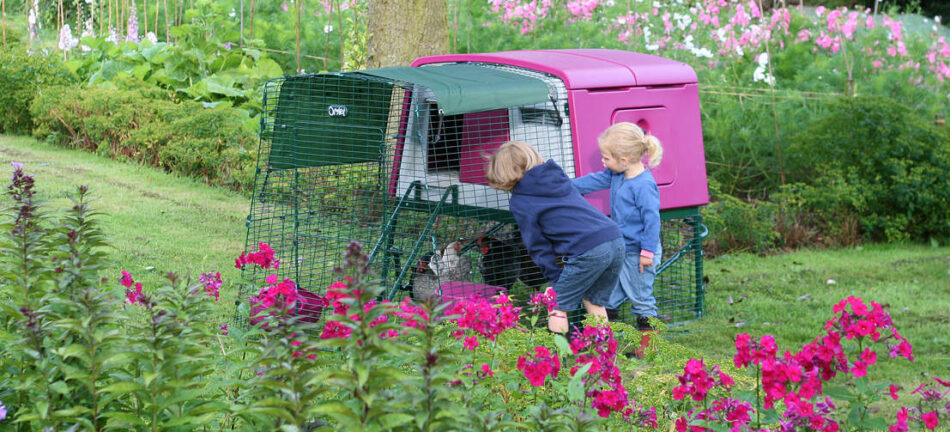
Composting companions
Are you tired of turning your compost pile? Let your chickens help! By giving your birds access to your compost piles, they’ll help the process along by keeping it bug-free and routinely turned. And while chicken poop might not be the most appealing part of having a flock, it’s actually great fertilizer! While your chickens scratch around in your compost, they’ll leave their own contribution!
Be sure to not let chickens have access to the compost until food scraps, coffee grounds, or other additives are decomposed to ensure they don’t ingest something harmful.
No more waste
No one likes wasting food. Thankfully, the majority of leftovers and kitchen scraps can be fed to your chickens! Consider keeping a container in your kitchen dedicated to the chickens for scraping plates into after meals. Most scraps and leftovers are safe to feed, but beware of too much salt and sugar. Foods harmful to your chickens include:
- Raw or uncooked potatoes and potato leaves
- High sugar processed foods such as doughnuts
- Tomato leaves and green tomatoes
- Eggplant or pepper leaves
- Raw or uncooked beans
- Coffee and coffee grounds
- Salty foods such as chips
- Uncooked rice
- Rhubarb fruit and leaves
- Chocolate
- Moldy or rotted produce
- Avocado
- Apple seeds
- Peach, apricot, cherry and pits
- Xylitol and other artificial sweeteners
Safe foods can be fed to your flock as supplemental feeding. The bulk of their diet should still consist of quality pellets and free-range options if possible.
Lawn ornaments
People have long decorated their lawns with various sculptures, statues, and other decor. Why not add living art to your decorating scheme?
Chickens come in a wide array of colors and sizes, and even have different textured feathers! Choose Silkies, Frizzles, or Polish to add some fun texture to your flock. Breeds such as Barred Rocks, Laced Wyandottes, or Mille Fleurs will add a pop of color to your yard that will rival any artificial accessory!
Much like keeping an aquarium, chickens add a beautiful and natural focal point to your home. And unlike fish, most chicken breeds get along with others, so mix and match to your heart’s content!
A backyard play-space
Chickens are naturally inquisitive and active! Create a backyard playspace for them to foster their natural curiosity. Some fun and entertaining options include: the Chicken Swing, Freestanding Chicken Perch, PoleTree, or chicken toys.
Like kids at a park, your chickens will get a thrill out of swinging, perching, pecking, and hopping around their own playground. Add some chicken-safe potted herbs or other plants for even more stimulating play!
Affordable
Chickens are one of the most cost-effective pets to own. They are inexpensive to obtain, and if free-ranging is an option, feed costs are kept to a minimum. If a flock is contained to a coop and run, a combination of quality pellets and scratch will keep them well fed and happy. Chicken treats are a great way to incorporate some free-range finds into a cooped-up flock. Additional inexpensive diet add-ins include lettuce, fruits and vegetables.
When you consider all of the benefits chicken-ownership has to offer, the return on investment is high! Fresh eggs, lawn care, pest control, entertainment, education, and companionship are just a few of the joys that come with caring for a flock of chickens.
What are some of the benefits of owning chickens that you have experienced? We’d love to hear from you!
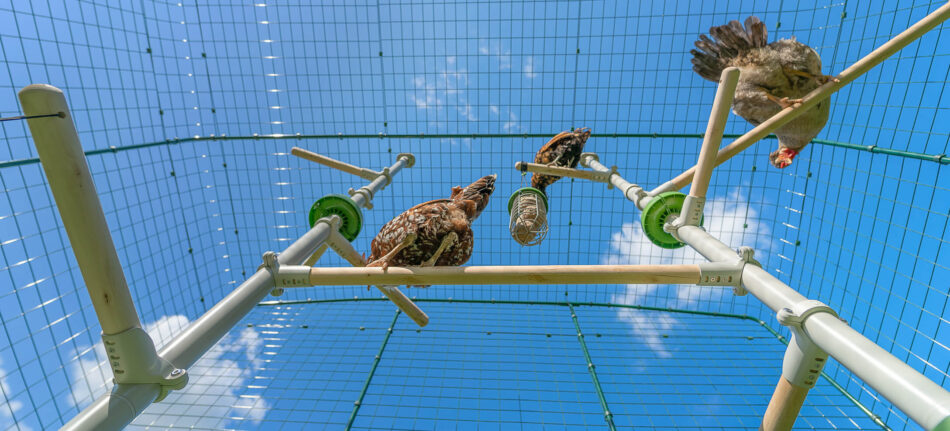
This entry was posted in Chickens
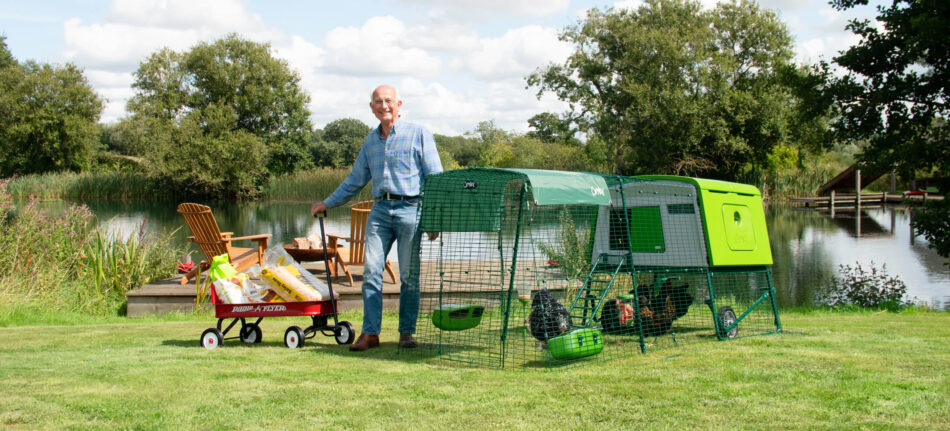
The Omlet Eglu Cube Chicken Coop helps make your chicken keeping lifestyle simple and fun! The double insulated walls ensure your chickens are always warm in the winter and cool in the summer, and the easy to clean surfaces make maintenance a breeze! But perhaps one of the best features that the Eglu Cube offers is its versatility!
Designed to fit flocks of all sizes, the Eglu Cube is the perfect coop for both the novice and seasoned chicken keepers alike. And if you are looking to create more space with your existing Cube, we’ve got everything you need to know!
Do my chickens need more space?
Whether you have 2 or 10 hens, you want your chickens to enjoy as much free range space as possible. Chickens aren’t that much different from us when it comes to space, and the more places we can explore, the happier we are! And the same is true for chickens! And we all know that happy hens = yummy eggs!
The Eglu Cube is the perfect hen house for all chicken keepers as it can house a wide variety of flocks:
- Up to 10 bantams OR
- 8 medium size hens OR
- 6 large breed hens
While the Cube itself is a perfect size space, allowing for even more room to roam is super beneficial to your feathered friends! Why? Because chickens like to have “personal space” just as much as any other animal! And at Omlet, who are we to stand in the way of a chicken and their space?
Versatility of Eglu Cube vs. traditional wooden coop
Our product designers carefully constructed the Cube with very unique features that allow for an easy housing system for both you and your hens! We know chickens and our mission with our designs is simple – provide a safe and easy to manage product that brings you and your animals closer and happier together.
So let’s take a look at just how versatile the Eglu Cube really is! We created the rear door panel to give you seamless access to the inside where you will find everything that you and your chickens will need. The separate nesting box creates a private space for the hens to feel comfortable and safe and also allows for chicken “alone time”.
Unlike traditional wooden coops that need to be painted and treated regularly, the Eglu Cube is completely maintenance free! A quick spray down with the hose to clean the messes and you will start to wonder why you haven’t been chicken keeping longer.
Walk In Runs and extensions
Are you looking to expand your flock? Or perhaps just add more space for your existing chickens to peck and play? Either way, we are here to help. Thanks to the modular and versatile design of the Eglu Cube, you can very simply create a henertaining playground for your chickens!
Walk In Chicken Run: The Omlet Walk In Run is truly customizable to fit any flock! Made from a strong and sturdy steel mesh, you can confidently place the Eglu Cube in the Walk In and let your chickens roam free without worry of any predator intrusion. The Walk In Run also provides a perfect way for you to actively engage with your feathered friends! Yes, even your 6ft tall friend can comfortably hug your hen as the run is designed for chickens – and humans! – of all sizes!
Chicken Run Extensions: Need even more space? No problem! The Omlet Chicken extensions were designed for exactly that purpose! With options of 3ft or 6ft widths and 3ft to 24ft lengths, you can literally customize your run to your specific needs. But what about when it rains? No need to worry! We have you, and your chickens, covered with the weather protection run covers! Rain or shine, your chickens will be just fine in the Walk In Run and Extensions!
Autodoor
The advancement of technology has made life easier for us, as well as our animals! And chickens are no exception. If you’re looking for the safest and most convenient way to let your chickens in and out of the coop, look no further than the Omlet Automatic Chicken Coop Door – the best hands-free chicken door on the market!
Chicken keepers everywhere love this door for its ease of operation and the added security it provides. Designed to fit both the Eglu Cube as well as a traditional wooden coop, the Autodoor can be operated by a light sensor or a timer. No longer do you have to jump out of bed in the morning or rush home at night to manually handle the coop door! Enjoy your life more freely knowing that your flock is perfectly safe with the Autodoor feature!
Wheels
A chicken coop on wheels? What more could any hen ask for?! By adding wheels to your Cube, you are able to find the perfect pecking spot in your backyard by moving your hen house anywhere!
And when the temperatures start to get colder, simply move the Cube closer to your house! Not only will your hens get the extra protection from your dwelling, but you also won’t have to walk too far in the cold to check on your chickens.
We know that you have many options when it comes to choosing a coop home for your chickens. That’s why we created the Eglu Cube to be everything a chicken keeper on any level could ever want or need. And with all of the extra accessories and options, your backyard beckons to be a spacious playground for your feathered friends!
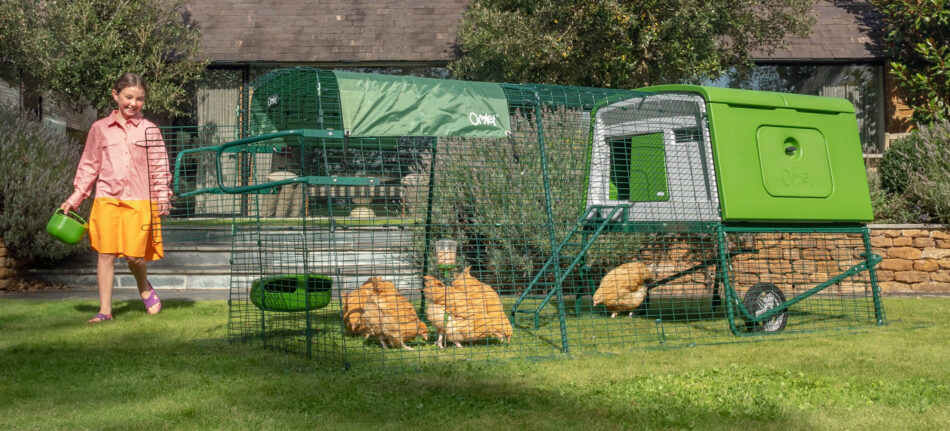
This entry was posted in Chickens

Choosing the best routine for your flock
Bedtime. This concept is either a highly anticipated event, or an absolutely dreaded one, depending on where you are in your walk of life. But for our chickens, bedtime is something that thankfully comes 100% naturally!
And what about mornings? Some of us rise early, ready to tackle the day, while others may take some slow coaxing to get into gear. Chickens fall into the first category – in fact, if they can’t start their mornings bright and early, they will raise an almighty ruckus!
So, what does that mean for you, the chicken keeper? Whether you let them free-range during the day or choose to keep your chickens safe in a coop-run combination, your flock will always feel most secure in a closed-up coop at night. But what if you need to go on vacation? Or what if you get sick? Get home after dark? Or simply forget? (It happens to the best of us!)
Enter: the automatic chicken coop door.
Imagine a morning where your leading ladies can strut right out of the chicken coop at the crack of dawn, even if you want to sleep in. Or a night where they put themselves to bed and the door closes automatically without the help of their human caretaker (if only human kids were as easy!).
But how do you determine the best bedtime for your flock? And what time is best to let them out to seize the day? Do you enforce strict bedtimes and wake times, or allow your flock to follow their own schedule?
Chickens have their own “auto” setting
Nature provided chickens with a sophisticated built-in clock that urges them to seek safety when night falls. You’ll notice your flock head for the coop when dusk starts to descend, nestling in together on roosting bars with their fluffy skirts facing out toward the coop door. Chickens are most comfortable when perched high off of the ground and huddled in the safety of numbers, with their backsides blocking the elements and dwindling daylight.
The automatic chicken coop door has its own sophisticated daylight setting that syncs with your flock’s biological rhythm. The integrated sensors close the coop door at dusk and open again at dawn so your girls can follow their natural schedules without the need to modify your own! And, the coop door’s light sensor can be fine-tuned by you, the now-sophisticated-chicken-keeper, to a specific level of lighting. Your chicken coop door can close right at dusk, as soon as all daylight fades, or some light level in between! This means that regardless of the season or your geographical location, your chickens will be closed safely in their coops as determined by the sun.
While it sounds nice not having to enforce poultry-bedtimes, the downside to this method is that predators also follow the same biological clock as our backyard birds. Earlier sunset also means earlier active times for coyotes, foxes, bobcats, and other furry fiends. Ensuring your chickens stay on schedule in addition to having a sturdy dig-resistant run is essential to their safety.
Coax your chickens to safety on a schedule
Chickens aren’t the only animals that take their cues from the sun. The majority of predators come out at dusk and stay active until dawn. Depending on your location, you may find yourself needing to usher your girls to safety before dusk and keep them secured in their coop an hour or two beyond dawn to avoid nature’s equivalent to rush hour.
We’ve taken this into consideration too! The automatic chicken coop door has a manual time setting that can be adjusted to the schedule of your choosing. Simply set the open and close times for morning and evening and voila – instant poultry bedtime enforcement.
Of course, this does go against the grain a bit for your feathered friends, so you’ll need to train and reward them well when adjusting to this type of schedule. But don’t fret – all you have to do is win the heart of one hen and the rest will follow! Save their favorite chicken treats when training them to come when called and place them in the same place inside the coop at the same time every day. Treat dishes or dispensers can be particularly helpful for coop training.
After a few days of coming when called and being rewarded with a tasty treat, your hens will most likely adhere to their new bedtime routine without reminder. But if not, you may need to continue feeding them at their specific time until the habit sticks. Some chicken-keepers prefer to continue feeding their chickens every evening as a bonding experience. Nightly feedings also allow for a brief examination of each hen to make sure everyone is healthy and happy.
For the “freebirds”
Not everyone loves a schedule – chickens included! If your flock has adapted a free-range, do-as-they-please lifestyle, they may not find the idea of bedtime appealing. By using the manual control setting on the automatic chicken coop door, you can still help them turn in at a respectable hour!
Simply press the open or close button to activate the coop door. While pressing a button might not make the automatic coop door fully “automated”, the door still opens and closes smoothly and safely, securing your free-spirits overnight.
Give them a night-light
Just like children, chickens are wary of the dark! When you’re pint-sized poultry, it’s easy to get scared by things that go bump in the night. That’s why we’ve created a literal beacon of comfort for your flock coming to bed after a long day!
The coop-light is synced with the automatic coop door. If the daylight or time settings are running, the chicken coop light will turn on 5 minutes before the door closes. This encourages your girls to head toward the illuminated safety of their coop before being tucked in! The coop light will automatically turn off after the coop door closes, making sure your hens have “lights out” at an appropriate time!
Since the coop light is controlled by the automatic door’s control panel, it can also be manually switched on and off. Quick roost checks are a breeze with the external switch, and the soft lighting won’t disturb your resting flock. And no need to worry if you forget to turn off the coop light before heading to bed yourself – the light will automatically turn off after 2 minutes to ensure no hens stay up too late!
Additional cooler-weather considerations
Along with the changing of our clocks comes the changing of the weather. Many areas of the US experience snow and cold temperatures well before daylight savings time ends, while other areas are just getting started with their winter preparations.
No matter where you live, it’s never too early (or late!) to prepare your chickens for a new season. Keeping your girls safe and warm all winter will help the overall health and wellbeing of your flock!
Do you have a cold weather check-list? If not, here’s one to get you started:
- Secure your flock in a coop overnight – ideally in a fully-enclosed space where they can huddle up and share their body heat
- Consider additional layers of insulation for extreme temperatures
- Be sure to feed a well-balanced diet and provide vitamins for chickens to offset the stress of temperature fluctuation
- Prepare for egg production and flock activity to reduce as a natural response to the days becoming shorter – you can read more here: Winter Chicken Keeping FAQs
Warm wishes and safe slumber
When questions arise, Omlet answers with a tangible, functional solution! We create, innovate, and push the boundaries of what “is” in order to produce high-quality pet products that help your furry and feathery family members live their best lives. Our horizontal-opening, fully automated, easy to install, night-light compatible, heavy-duty, all-weather automatic coop door is just one of the many products created through this line of thinking. But don’t just take our word for it – check out what real-life flock raisers have to say about our automatic coop door: 8 Things Chicken Keepers Love About the Autodoor.
Remember, our clocks turn back on November 6th, 2022 (unless of course you live in Arizona or Hawaii!), so be sure to adjust your automatic chicken coop door settings if necessary. The daylight setting will automatically adjust as the sun sets earlier, but scheduled open and close times will need to be changed. Be sure to give your flock a heads-up when moving bedtime up an hour! Start putting them to bed a little earlier each night to make sure they’ve got their new routine down by November 6th, and to make sure no one gets left out in the dark!
No matter where you live, how big your flock is, or how much space you have, it’s our goal to help you provide the best possible bonding experience for you and your pets. Whether you want full-automation when it comes to closing your chickens in for the night or enjoy the everyday interaction of tucking them in as it gets darker, the automatic coop door gives you peace of mind when telling your flock good night. So, here’s to staying warm and safe this season – the fun, innovative way!

This entry was posted in Chickens
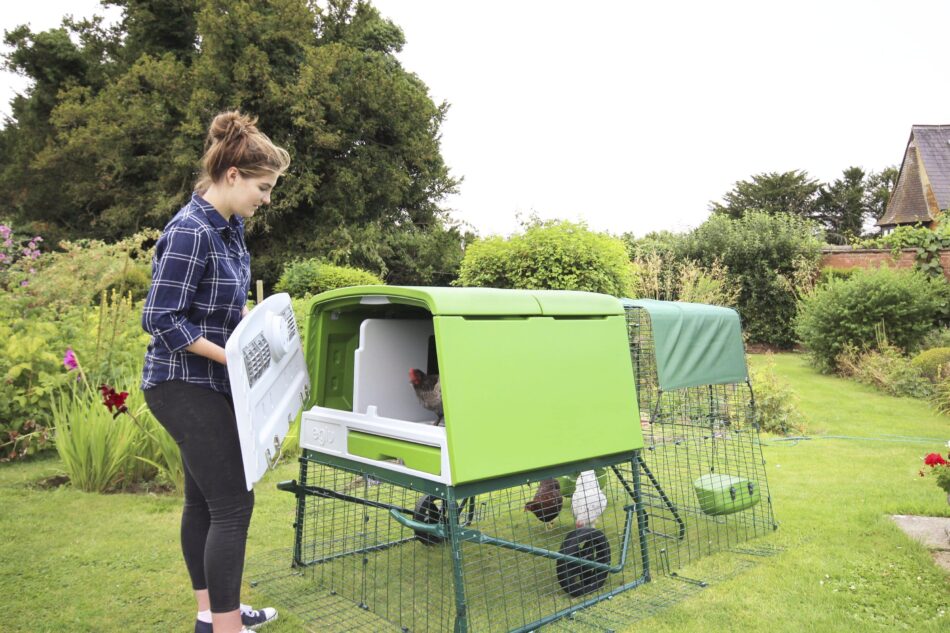
A quick search on the internet will provide a plethora of chicken coop options to purchase. But not all coops are created the same! At Omlet, our product designers know that keeping chickens is fun and simple, which is exactly why they created the easy to assemble and quick to clean Eglu Cube Chicken Coop.
Why you need an Eglu Cube
While wooden chicken coops have traditionally been used to house hens, there are better options available! Before you go buying a mini-house lookalike, take a read over all the reasons the plastic Eglu Cube is the best option:
- The material your coop is made of matters! The Omlet Eglu Cube is made of hard, durable plastic making it resistant to termites and parasites. Unlike a traditional wooden coop that needs to be treated, painted, and reroofed regularly, the Eglu Cube doesn’t require any of that maintenance – think of all the time and money you will save!
- The easiest to clean coop on the market! The product designers made this coop with clean-up in mind so all of the surfaces are easy to wipe down in minutes. No more need to worry about smelly chicken coops! In fact, all of the Eglu parts are easy to remove and even pressure wash clean if needed. Your hens will thank you for a sparkly clean and hygienically healthy home!
- It’s a weatherproof wonder! Chicken keepers from Florida to Fargo can attest to the outstanding weather performance of the Eglu Cube! Carefully designed with a unique double-wall insulation system, the Eglu allows your chickens to stay warm in the winter and cool in the summer. When tested against a traditional wooden coop in the cold winter of Germany, we concluded that a winter ready chicken coop like the Cube can make all the difference between a cozy night’s sleep and one spent shivering to keep warm!
Hassle-free Cube = hassle-free chicken keeping
Some people may object to keeping chickens for reasons that include smell, time commitment, and space. But the reality is that these are all just chicken myths, and with the right products and preparations, chickens are low-maintenance pets. The Eglu Cube from Omlet helps to make that job easier!
SMELL
So you think chickens in your backyard might create a bad smell? Well, the truth is, chickens are actually clean animals. The smell that many are afraid of isn’t from the chickens themselves, but rather from the chicken droppings. But, with the easy to clean Eglu Cube, you can spray down your coop in minutes and avoid any unpleasant odors.
TIME
Like any animal, owning chickens requires a time commitment! Just like cats and dogs, they need daily food and water and physical and mental stimulation. Other than that, they are self-sufficient animals! Investing in the Eglu Cube allows you to save even more on time with its easy assembly! We had the novice chicken-keeper in mind when designing this coop, so we created a product that is super easy to put together. In fact you just need one tool to get started!
SPACE
Probably one of the biggest myths in owning chickens is that you need to have a huge backyard to house your hens! For the average chicken-keeper, a regular sized backyard will do just fine! The great thing about the Eglu Cube is that you can opt to add wheels to the coop allowing for it to be movable by one person to another location. What chicken wouldn’t like a house on wheels?
Step-by-step guide
Choosing the right chicken coop can be the hardest part of chicken keeping. So now that you have decided on the Omlet Eglu Cube, let’s take a look at the 7 simple steps to assemble your hen’s new house!
- STEP 1: Grab a screwdriver and a friend. Yes, that’s all you need to put together this super easy to assemble coop! All of the materials are included in the boxes upon arrival, so you simply need to lay everything out to get started. If you want, you can even watch this tutorial video to follow along each step!
- STEP 2: Now it’s time to construct the frame! With the help of a friend, follow the detailed step-by-step instruction manual to build your coop base. Made from heavy duty steel, this frame is not only strong but will keep your chickens safe and secure.
- STEP 3: Now it’s time to get rolling! If you opted for the wheel accessories, this step includes their installation. The moving mechanism of the Eglu Cube wheels was created to allow for one person to move the coop with ease!
- STEP 4: Time to install the run – a chicken’s favorite part! The size of the run you buy depends on how many chickens you plan on keeping. The goal should always be to give your chickens the most space you can – either free range in the backyard or with a bigger walk-in chicken run. And if you find it hard to decide which is best for you, just contact our customer service and we will be happy to help!
- STEP 5: You’re almost there! Now it’s time to assemble the cube house and attach it to the frame! Made from 100% recyclable and UV stabilized polyethylene (super strong plastic!), you will have peace of mind knowing your chickens are in the best built hen house on the market.
- STEP 6: It’s accessory time! One of the greatest benefits of the Omlet Eglu Cube is all the optional accessories you can add to your hen house! The essential feeder and waterer bins are constructed from the same strong material as the house and designed to be just as easy to clean! You can also add the automatic chicken coop door which allows your chickens (and you!) to sleep soundly at night knowing that predators cannot get in!
- STEP 7: All that’s left to do now is add your flock! You have just built an efficient and practical home for your chickens that can stay with them for years to come.
Maintenance of your coop
While Omlet products are known for their durability, we always recommend regular maintenance on all products to ensure you will get the most out of them! The Eglu Cube is practically maintenance-free with its super easy to clean design, but there are few things you can keep your eye on when out and about with your chickens to make sure stability and security are 100%.
- If you notice any run clips not as tightly secured, it may be time to replace them.
- If you are a seasoned chicken-keeper and purchased an Eglu Cube before summer 2019, you may start to notice some wear on the previously provided friction stair strips. Consider upgrading your coop with the Eglu Cube ladder grips that not only make it easier for your chickens to walk in and out of the house, but are more durable as well!
- While the cube house is completely covered and protects your chickens from the elements, many chicken-keepers add run covers for added protection when the chickens are roaming the run.
One of the greatest gifts of chicken keeping is, of course, the benefit of wholesome, fresh eggs! But chickens can also be very henertaining! After long, you will notice you are loving your chickens just as much as your four-legged pets. So when it comes to making sure they have the best life possible, be sure you get them the best house!
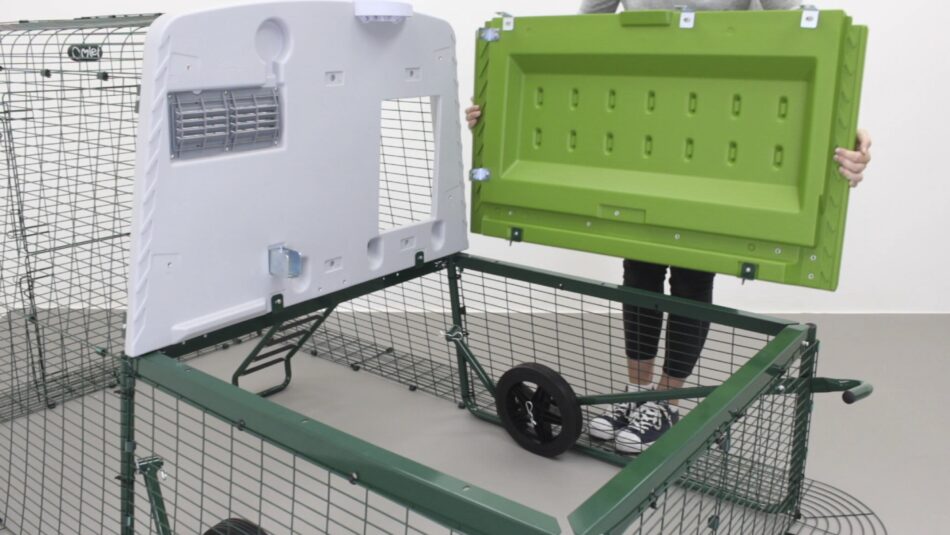
This entry was posted in Chickens
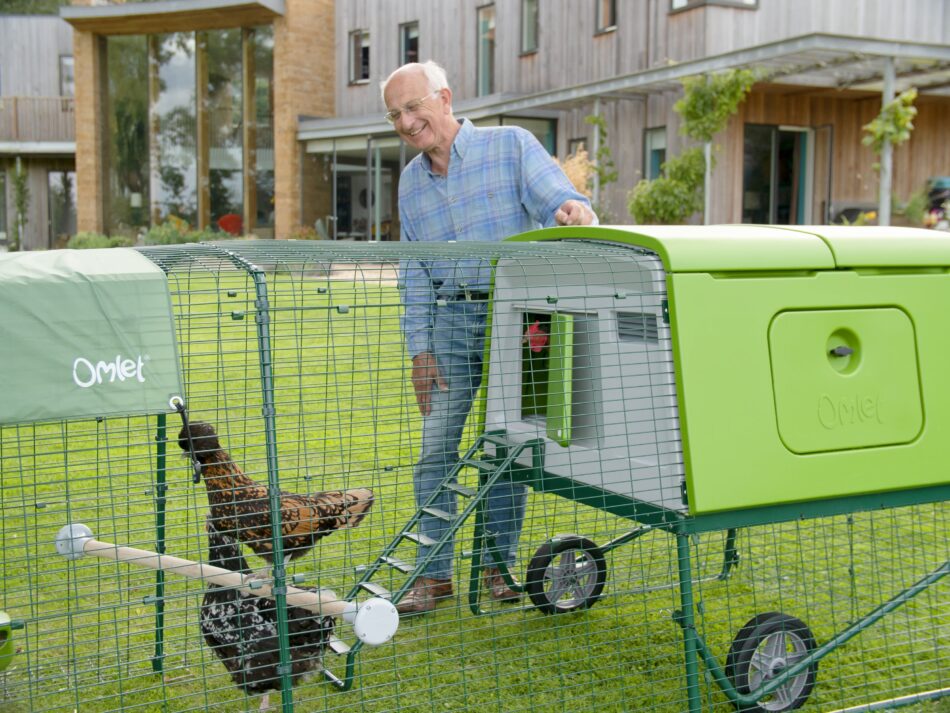
What’s there not to love about a little autumnal getaway from the hustle and bustle of daily life? Long walks in the countryside with the crunching of crisp leaves beneath your feet, or maybe for you it’s endless hours inside relaxing and avoiding the elements and enjoying the sound of chirping birds from the comfort of a cosy cottage. Speaking of…what about the chickens at home?!
If you didn’t make it on a summer holiday this year, you may have never experienced being away from your feathered friends for more than a few hours. So, what exactly do you do when you’ve made the decision to leave your chickens?
What is a chicken sitter?
Babysitters, dog sitters, and even cat sitters are terms we’re all familiar with, but what about a chicken sitter? Just as you would when leaving beloved fido for a few days, a chicken sitter is a trusted individual or group that can take care of your chickens in your absence. This might be a friend, neighbour, family member, or even someone from a reputable, trusted chicken sitter directory.
How long can chickens be left alone for?
Leaving your flock to their own devices is a bit different to leaving another pet such as a dog or cat at home. These amazing animals are pretty self-sufficient, so can be left alone for up to 3 days before you should have to consider a chicken sitter. This being said, it won’t do your chooks any harm either, should you want someone to keep a beady eye on them even if you’re only going away for the night! Most importantly, chickens need constant access to food and water that won’t run out, and enough space in their enclosure to move around.
Whilst chickens are relatively low-maintenance, we still know just how important it is to you to make sure your feathered babies will be well looked after when you’re not there. That’s why we’ve compiled a list of these essentials that will help not only the lucky chosen chicken sitter, but also for you to feel reassured, and of course for your chooks to remain safe, comfortable, and happy during your time away, regardless of how experienced (or inexperienced!) your chicken sitter is. Now, are you ready to bid bye-bye to the girls for a few days? Here are the essentials.
The essentials
A secure chicken coop
The best way to make sure your chickens are safe is with a predator-resistant coop such as the Eglu Cube from Omlet. Thanks to the unique anti-tunnel skirt, pesky predators will be deterred from trying to break or dig through the coop, meaning that you can be assured that your hens will have the best levels of protection whilst you relax on holiday. Take a read of our How Strong Are Eglu Cube Chicken Coops? where our Eglu Cube chicken coop was really put to the test (p.s. It survived a black bear attack!).
As well as being incredibly secure, all of the Eglu chicken coops have been expertly designed to be super simple to clean. So whether your hens are in the capable hands of an eggspert chicken keeper or amateur Auntie Alice, looking after chickens has never been easier. The Eglu Cube’s smooth, wipe-clean surfaces and slide-out droppings tray mean that your chicken sitter can have your hens’ home sparkling clean in just minutes! Watch this clip to see how sensationally speedy Cube coop cleaning can be.
Hentertainment
It’s key to make sure that your chickens stay hentertained whether you’re there or not. Having bored chickens can lead to unwanted behaviour such as egg eating, so it’s important to keep their brains mentally stimulated. And just as with other pets, you can encourage this through play. Make sure that your hens have an unrivalled garden setup before your travels, which can be created using toys such as the Caddi Treat Holder and Pendant Peck Toy, which can easily be refilled by your chicken sitter. Not only do chicken toys provide chooks with hours of entertainment, but also help to improve coop hygiene by keeping food off the ground – even less cleaning for your chickens’ provisional parent!
Poultry playground essentials
Another great addition for your hens before you go is the PoleTree Customisable Chicken Perch. Choose the perfect perch kit for your flock, assemble it in a few simple steps, and your chickens will do the rest! It’s a great opportunity for your chickens to show off their impressive perching skills to their sitter too!
If you’re happy to keep your chickens free ranging with your chicken sitter, the Freestanding Chicken Perch will suit your poultry playground perfectly. Just like the Poletree Chicken Perch, the Freestanding Chicken Perch is completely customisable, so will keep your chickens hentertained, with the perches adjusted to their abilities and needs. Don’t forget to set up your perch before heading off, and give your hens the chance to get used to their new accessory.
An automatic chicken coop door
An automatic chicken coop door is next on our chicken sitter essentials list. This is a must-have if you want to ensure your hens’ routine remains the same whilst you’re away. Omlet’s Autodoor allows users to choose from 3 unique settings to fit their lifestyles. Opt for the light setting and your Autodoor can be automated to close at dusk and open at dawn. The time setting means that you can choose an exact time for the door to open and close, whilst the manual setting gives chicken keepers the option to control the door however they wish.
This makes the Autodoor perfect for when leaving your chickens with a sitter, knowing that you can still remain in control of bantam bedtime. What’s more, the Autodoor has built-in safety sensors, meaning that you needn’t worry about any feathery obstructions getting trapped.
If you haven’t quite got your hands on an Eglu chicken coop just yet, then the Autodoor can still be attached to any wooden chicken coop, maximising the security of your chickens’ enclosure whilst you’re on holiday.
The ultimate thank you gift!
You’ve made it a week away from your chickens! No doubt, you’ve missed your flock tremendously but know that they have been left in capable hands following our chicken sitter essentials guide! By now, your chicken sitter is already convinced to get a few of their own (if they haven’t already!), but it’s also time to say thanks with the ultimate thank you gift, and what better than a kitchen accessory to store the delicious eggs your hens have been laying all week.
Omlet’s Egg Skelter is a great choice, coming in 3 colours to fit the design of any home. It’s also an eggcellent way of keeping hens’ eggs in date order, to ensure optimum freshness. Alternatively, go for the Egg Ramp as the ultimate chicken sitter thank you gift. The bold design stores up to 12 eggs and conveniently keeps them at room temperature.
Leaving any pet behind isn’t easier, regardless of how long you decide to go away for. Most importantly, is that you are confident in who you have decided to leave your chickens with, But with these chicken sitter essentials, it will mean happy holidays for you and as less stress as possible for your chooks!
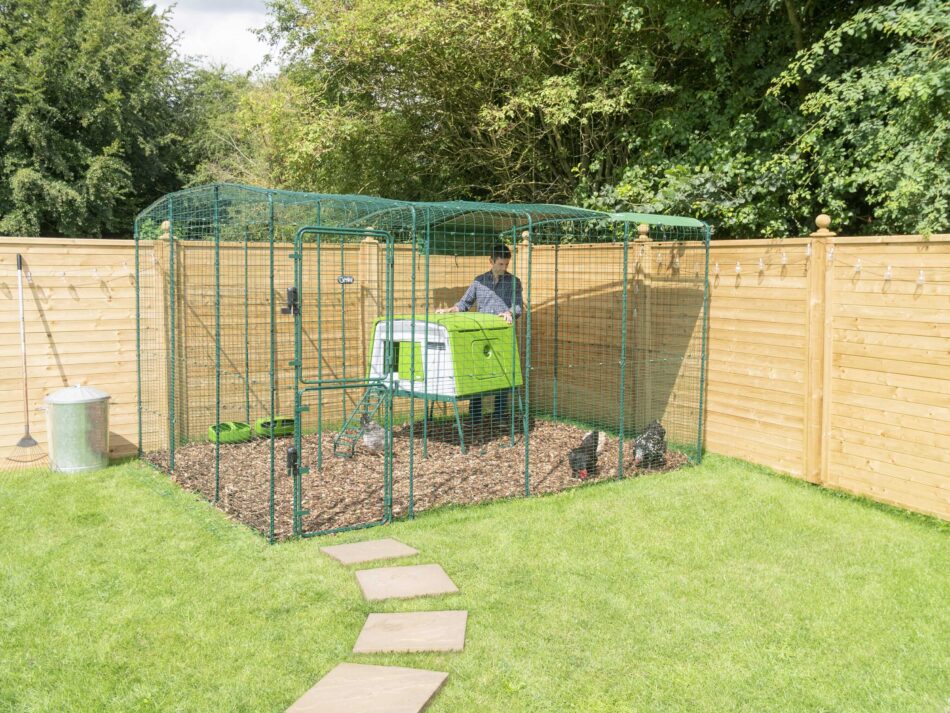
This entry was posted in Chickens
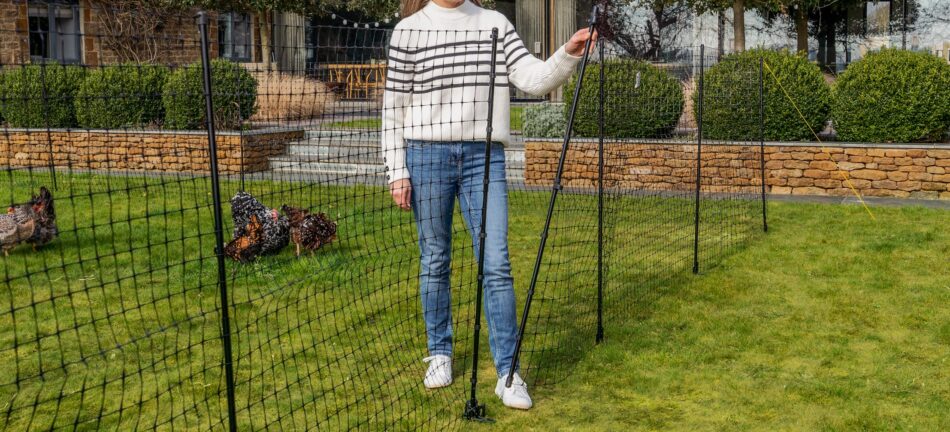
Choosing between chicken wire and chicken fencing is one of the first steps in getting your new hens set up in their new home. Both products focus on keeping your chickens safe within their new home. Our guide explores the key features of chicken wire vs chicken fencing, to help you decide which is right for you and your flock.
What is chicken wire?
Chicken wire is a type of wire mesh, most typically made from steel that is used to pen in chickens. The wire is thin and flexible, with the steel formed into hexagonal gaps that can vary in size. As well as using chicken wire for your flock, many people put it to other uses in their backyard. From creating pens for small animals, to protecting your plants, it can be used for a variety of tasks in the garden.
What is chicken fencing?
Chicken fencing does the same job as chicken wire, however it is more durable, and far easier to install. The fencing allows you to chicken-proof your yard, whilst easily giving your hens space to roam. Made from stronger materials, such as aluminium and polypropylene. You’ll also find chicken fencing tends to be higher than traditional wire solutions.
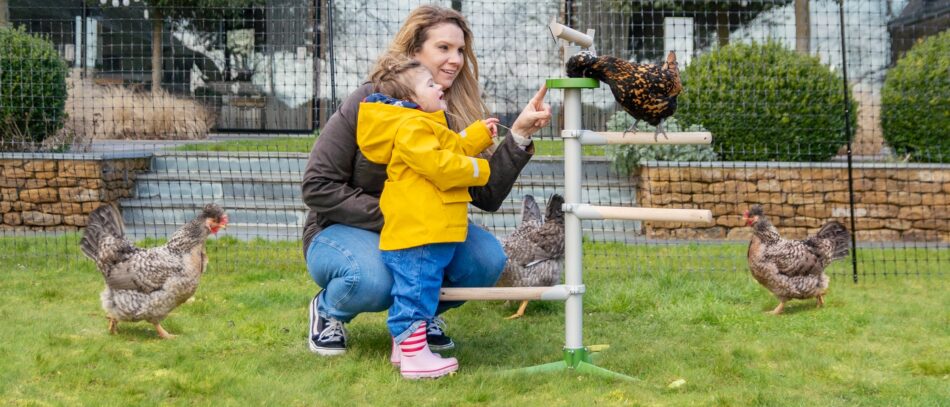
Chicken wire vs chicken fencing: 3 key differences
Designed to perform the same job in slightly different ways, there are 3 key differences when comparing chicken wire vs chicken fencing. These are what to look out for:
- Height – Although they can’t get very high, chickens can fly and so it’s important to have a garden solution that they cannot escape. Chicken fencing is designed to be higher than chicken wire, meaning your hens will be prevented from flying away!
- Durability – Chicken wire and fencing tend to be made from different materials, which is the main feature that sets them apart. The wire is most commonly made of steel, whilst fencing can be made from sturdier plastic materials.
- Ease of use – Chicken fencing is designed in a way that ensures it doesn’t tangle, and comes with easy to install poles so you have your hens roaming in no time. Whilst chicken wire is fine and can easily get in a mess which you’ll have to untangle. You may also have to attach it yourself to wooden poles.
Is poultry netting the same as chicken wire?
Poultry netting is another name for chicken wire, and is used to pen hens into their chicken coop. For an extra level of protection for your chickens, you can choose an electric poultry fence that will deter predators. We would however still recommend taking further precautions as well as this to ensure your flock is safe.
Are chicken wire & chicken fencing predator proof?
If you’re raising a flock you want to keep them protected from pesky chicken predators. Unfortunately, whilst chicken wire is excellent at keeping your grown hens in – it’s not quite as good at keeping predators out. The hexagons within the wire allow effortless access for racoons and snakes, as well as being big enough for baby chicks to escape. Whilst the thin nature of the steel can be easily chewed through by larger predators, such as foxes.
Many hen keepers use the chicken wire to cover the top of their chicken runs to ward off larger air-borne predators.
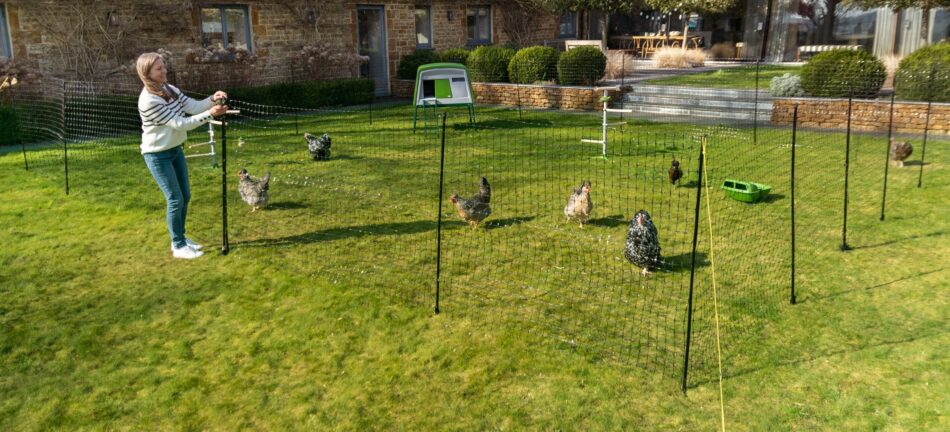
Like chicken wire, chicken fencing is also not designed to be predator-proof – rather it’s sole purpose is to expand the space your hens are in. Whilst your flock are roaming around the space given by their fence, you’ll want to keep an eye for predators as they may still be able to chew through the netting. A walk in chicken run will provide greater protection from predators if you need to take your eye off the hens.
Which lasts longer: chicken wire vs chicken fencing
As it is made from thin steel, chicken wire is prone to rust and corrosion. This means you’ll find it only lasts up to 5 years, with you needing to replace it frequently. Those who live in a wet climate, with moist soil will find it rusts quicker than those in drier climates.
As it is made from more durable materials, chicken fencing is likely to last longer than traditional chicken wire. This means you won’t find the need to replace it quite so often. The fence is also far more stiff that ensures it doesn’t tangle in the same way as chicken wire, which also helps to extend its longevity.
How many types of wire fencing are there for chickens?
Chicken wire can come in a variety of metals, but galvanized steel versions provide the best strength and durability. As with choosing between different chicken coops, you’ll want to find the perfect wire for your hens. You’ll also find that the wire comes in different diameters, choosing a higher gauge will make it more difficult for animals to gnaw through the chicken wire. You may also wish to consider the size of the hexagons the wire creates, as ones that are too large will be easier for small chicks, and predators to slip through.
Chicken fencing at Omlet
Omlet’s Chicken Fencing is the ideal choice for giving your chicks extra space in your backyard. With unique benefits that make our fencing the ultimate choice, you and your hens will love your new fence!
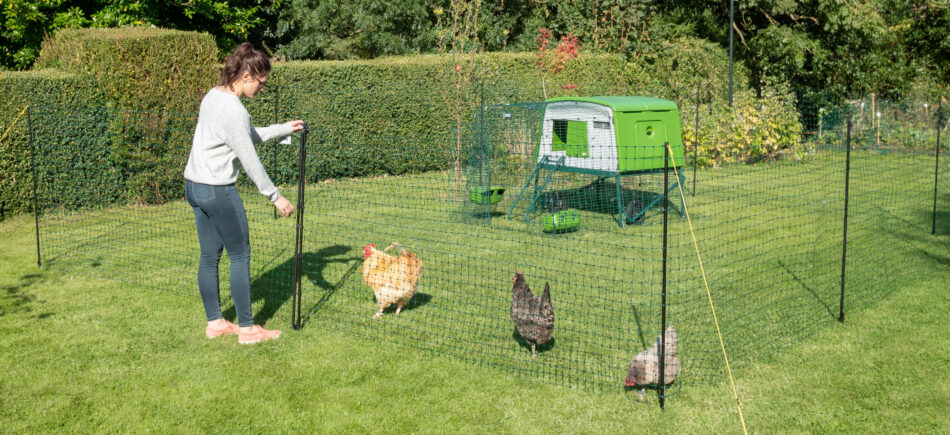
- Taller – Depending on what breed of chicken you have, they may fly a little. We’ve made our fence high enough that your hens shouldn’t be able to escape.
- Connectable – If you already have a run, or want to connect the hen fence to your garden fence, we have a wall connection kit that will help you attach the two with ease.
- Blends into the backyard – Our improved fencing comes in black that blends seamlessly into your outdoor space.
- Easy to install – Tangle-proof netting, with adjustable poles makes our fence super easy to install. Each pole comes with two spikes for stability that can be trod into the ground easily.
- Reflective – Safety is important in any outdoor space. Our chicken fencing has high-vis guy ropes, as well as reflective badges on the fence itself so you can spot it at night.
- Gate for easy use – For those wanting to get in and out of the pen to see their hens, our fencing comes with a simple gate system so you can have access to your chicks.
Petcare from Omlet
For keen chicken keepers, we have everything you need for happy hens. Customize their coop with fun chicken perches, chicken toys, and even protect them against the elements with our weather protection for coops and runs.
This entry was posted in Chickens
Amy Wolsey lives in Norfolk with her 11 happy hens. She’s kept busy with 6 Cream legbars and 5 Pekin Bantams. They, like her Springer Spaniel Oliver, love to help her in her backyard and vegetable patch! Follow Amy on her Instagram account chicksandveg.
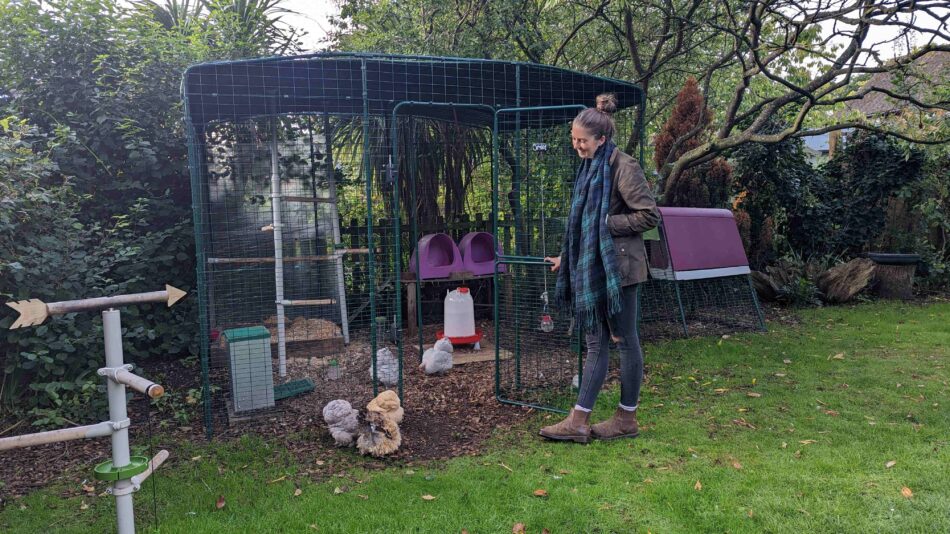
Wasn’t that a long hot summer we had in the UK? Well it certainly feels like we’re changing seasons now with the arrival of some cooler temperatures and darker evenings. Just like we dig out the jumpers from the wardrobe and crave warming soups rather than salads for lunch, it’s time to start thinking about keeping our chickens happy over fall and into winter. Now, I’m not suggesting we wrap our chickens in cosy jumpers! But, there are some things we can do to make sure they stay healthy and comfortable in the coming months.
Health check
It’s a really good time to think about giving your chickens a general check over and looking for anything unusual. I keep an eye on my chickens all the time and look for changes in behaviour or differences in their condition but a closer look every once in a while at their feet, feather condition, head and combs is good practice. It’s also particularly important to check your hens are happy at this time of year as most go into moult. Moulting is when chickens shed any damaged or loose feathers and replace them with a fresh set. It usually happens over a few weeks and they might look a little scruffy as the new feathers grow but it’s totally normal. Growing new feathers is quite a big job and as feathers are mostly protein, I like to give my hens a boost to help them along. I add extra protein and calcium to their diets with some supplements and purchase some extra treats for them to enjoy!
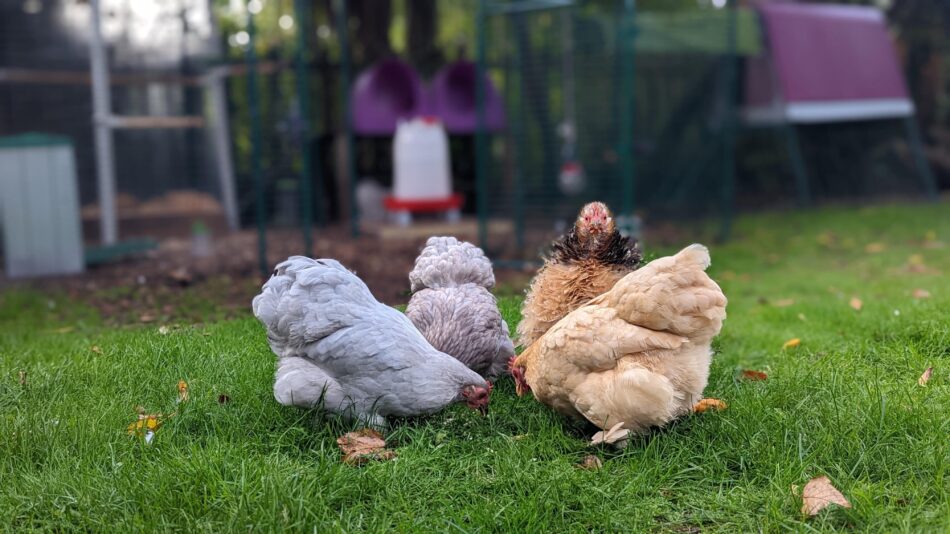
Deep clean
I regularly clean my coops but a change of season always gives me the motivation to do a thorough deep clean so everything is sparkling ready for wetter, muddier weather. With the Omlet chicken coops being plastic and so easy to keep clean, I like to give them a proper hose down before disinfecting and adding some fresh bedding. It’s also a really good chance for me to check round the runs and make sure everything is secure. I’m even thinking of adding an extension to my run later in the year so all the hens can be together so this is a good chance to plan it out!
Weather protection
Speaking of my chicken run, I’m going to add some more protection to the sides to keep things cosy over winter. I’ve got the heavy duty covers for the roof which keep it lovely and dry! It’s so important for chickens to have a dry space over winter. Lots of wet mud isn’t good for chickens and can cause all sorts of problems with their feet but also, it’s just not nice for them to move around in. Plus, chickens love a dust bath even over winter. And especially when they’re going through a moult, it’s nice for them to be able to scratch and clean those feathers! When thinking about your run, it’s also worth considering protecting the sides too and providing a bit of a wind break so the Omlet clear covers will be perfect! There’s even some cosy insulating blankets I can put over the coops in the depths of winter. The Eglus have twin walled construction so it’s not a must but with the crazy weather we’ve had this summer, who knows what to expect! Plus, any excuse to treat my hens to something new!
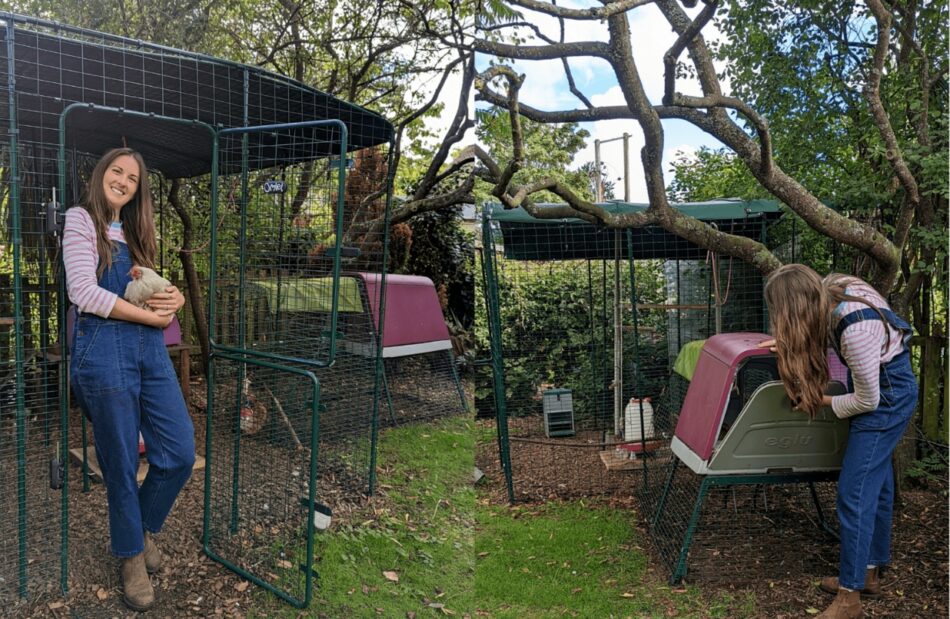
All in all, fall is a great excuse to give things a check over and refresh whilst keeping my hens happy, cosy and healthy! Now, where are my woolly jumpers…
This entry was posted in Chickens
Social Media Executive Rosie has been at Omlet for a year, and when she was asked by her managers if she was interested in broadening her chicken knowledge (and creating fun content for Omlet’s social media platforms) with her very own flock, she said yes straight away.
Read on to find out what the chickens have been up to in the summer heat, as well as some useful tips and advice from the British Hen Welfare Trust.

What’s new?
We decided to upgrade our setup and get the Omlet Chicken Fencing. The hens still really love free ranging outside the run, but they were pooing all over the patio where we have dinner in the yard, and scratching up all the stones from the borders and spreading them across the lawn. I do love the chickens, but it was getting slightly tedious.
With the fencing they still have a lot of space, but they are limited to the grass. That’s their favorite bit anyway, so we all win.
Has Evie the dog got used to the hens yet?
She has, actually. It took some training, but now she knows not to go for them. That’s another great thing about the fencing; even though she’s far from as interested in the chickens as she was in the beginning, I still don’t completely trust her. The fencing works as a nice barrier between them, so that we can all be out in the yard at the same time.
I appreciate it might not work for all dogs, but it’s been great for us.
Since Rosie started sharing her chicken experience on the Omlet social media accounts, she has received plenty of positive feedback from the community – as well as quite a lot of questions!
I’m far from a chicken expert, I’m still learning a lot and I couldn’t really be of help when people were asking questions about their flock.
One thing that has been great when I’ve been worried about my hens has been the BHWT Helpline. Anyone can call or email them, you don’t need to have rescued hens, or even live in the UK. So I got in contact and asked if they could help with some common questions I often see on the Omlet Facebook Group, and they were really helpful. I hope it’s helpful!
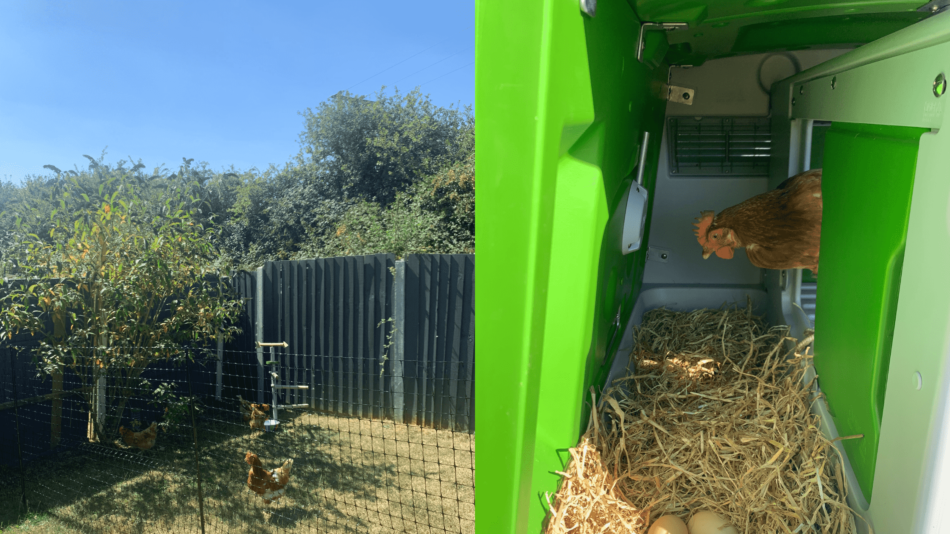
My hen is struggling to lay, what can I do to help her?
She could be egg bound. Egg binding is when a hen is unable to lay an egg in her system. You may have noticed your hen, who usually lays daily, sitting in her nest box for long periods. If she doesn’t produce an egg after multiple visits to her nest box, try a warm bath followed by a lubricant such as Vaseline just inside and around the vent to help her pass the egg. Placing her in a dark secluded place to nest away from other birds will also help.
If she starts to become distressed and doesn’t lay an egg, it’s advisable to seek veterinary help.
My hen has laid an egg with a very thin shell that breaks when I pick it up, is this OK?
A thin-shelled egg is usually due to a calcium deficiency, so feed a good quality layer’s feed which has balanced nutrients. You can improve shells too by cutting back on the treats you feed daily. Finally, there’s a chance your hen may be going off lay or moulting which will also have a bearing on shell quality.
One of my hens is being attacked by the others, shall I remove her?
If one hen can be identified as a bully it is better to remove her from the flock for a few days; this will drop the bully down the pecking order. Only remove the weaker hen if she has been injured, but try to house her within sight of her flock mates and reintroduce her as quickly as possible; make sure she has individual access to feed and water for short periods and give her some TLC, she’ll soon learn you’re her best friend.
My newly adopted hen is limping, why is this?
It is not uncommon a couple of days after adoption to see some limping due to bruising, but this should quickly resolve. If it doesn’t please contact the Hen Helpline and we’ll help you check thoroughly for any underlying issues.
My hen is standing really upright and waddling like a penguin, what is wrong with her?
This sounds like it could be egg peritonitis. Many hens cope very well with this condition, especially if fed just on a mixed corn diet. However, occasionally a hen may require antibiotics which you would need to get from your vet who may suggest a hormone implant to temporarily take her off lay.
My hen’s crop feels like a deflated water balloon. When I pick her up there is smelly brown fluid coming out of her vent and she keeps flicking her head. What is it and what should I do?
This sounds like it could be a sour crop. We recommend you call the BHWT’s Hen Helpline and chat to one of their team who will guide you and/or suggest if you need to seek veterinary help.
This entry was posted in Chickens
The Eglu Cube chicken coop is built to last – whatever gets thrown at it. The durable, twin-wall chicken house and heavy duty, steel weld mesh is strong enough to protect your chickens from hurricanes, tornadoes, bears, bobcats and more. These case studies are just some of the many stories from happy chicken keepers around the world.
This Eglu Cube survived a hurricane!

All parts for the Eglu Cubes are available as spares so if anything gets damaged you can easily repair it. Contact our friendly customer service team by email or phone, and they’ll be happy to help.
The Eglu Cube chicken coop holds firm against strong winds and hurricanes, and is easy to tie down or move into a sheltered area. After Hurricane Ian hit Florida at 150 miles per hour, Jeremy was astonished to see his Eglu Cube still standing, unmarked in the thick of the aftermath.
“Our Eglu (unbelievably) survived Hurricane Ian. We are 3/4 of a mile from the Gulf of Mexico near where the hurricane made landfall. Venice is badly damaged. Our neighbourhood, in particular, took a very big hit.
Our entire back yard was destroyed. The fence is a complete loss. Several large (30+ foot) pine trees fell down, including one into the neighbour’s roof and one that snapped the power pole in half. But the Eglu did not have a single scratch. We moved the chickens back in right away.”
Jeremy – Florida, USA.
This Eglu Cube survived a bear attack!

When you live in a rural area, with black bears for neighbours, it’s understandable to be worried about your chickens. But Tom’s Eglu Cube quite-rightly earned his trust when a 300 pound bear was unsuccessful in its attempt to break and enter his chicken coop in Virginia.
“We live in an area with black bears, coyotes, foxes, and other predators. Over the weekend our Eglu was attacked by a 300 pound black bear and despite the wire roof being smushed with its weight, the Eglu remained intact and no chickens were harmed. We most likely will need an electric fence but we were impressed with the coop being able to withstand the assault. Very impressed! Also, with 2 young children the Eglu is easy to clean and maintain – minimal maintenance required and our boys able to open and close the doors. Outstanding! The best coop we could have with our rural area and lifestyle”
Tom – Virginia, USA.

Over in California, Tracy and her sweet silkies also had an unwelcome visitor in the form of a large bobcat. But thanks to the Eglu Cube, Tracy enjoys peace of mind knowing her girls are safe and sound.
“We are the Lloyds, and we live in San Diego, CA. We have four silkies – Elsa, Nugget, Ickey, and Shuffle. They are the cutest and sweetest, little bunch. They like to stick together, and scratch for bugs, worms, and other treats.
The predator in the video is a bobcat, but we also have coyotes, owls, hawks, and more. Our house backs to a canyon, and we have frequent visits from various predators. We have so many visits, that I do not allow my poodles to go outside in the backyard unless they are next to us, and we are actively watching them, but I’m confident the hens are safe in their coop.
We purchased an Eglu Cube because we love our silkies, and we wanted to keep them safe. Although we still have a motion-sensor camera to monitor, the silkies have been happy and safe!”
Tracy – California, USA.
This Eglu Cube survived a fallen tree!
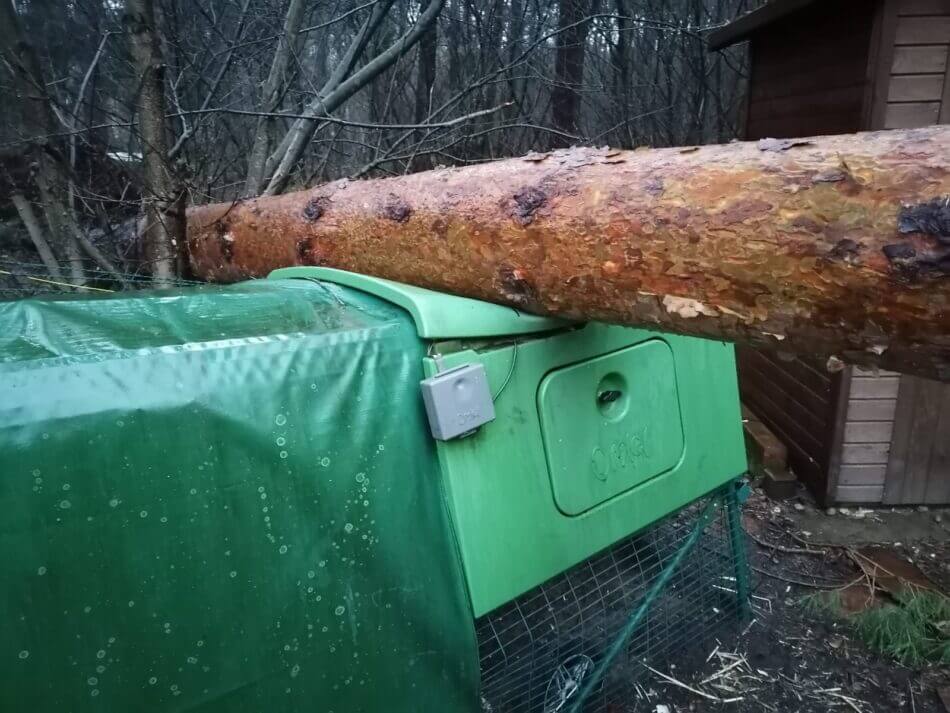
Thanks to the thick, twin wall house and steel frame, the Eglu Cube chicken coop is unaffected by the roughest of storms and its path of destruction. Anna from Germany saw for herself when a fallen pine tree squared up to the Eglu Cube.
Man, did we have a few stormy days! Everywhere in the neighborhood, trees were falling left, right and centre, and one of them on the edge of our premises, exactly where our Eglu Cube chicken coop is!
The giant pine tree fell across our Cube, but when we came out to check on the hens we couldn’t believe our eyes. The tree was resting right on top of the Eglu, but it hadn’t been damaged at all. As soon as the Autodoor opened, the chickens walked out and started to scratch around as if nothing had happened, and we could collect fresh eggs that same afternoon.
After some serious chainsaw work we were able to investigate the Cube, finding that only one roof panel was damaged, but we could even bend that back a bit. Unbelievable!”
Anna – Germany
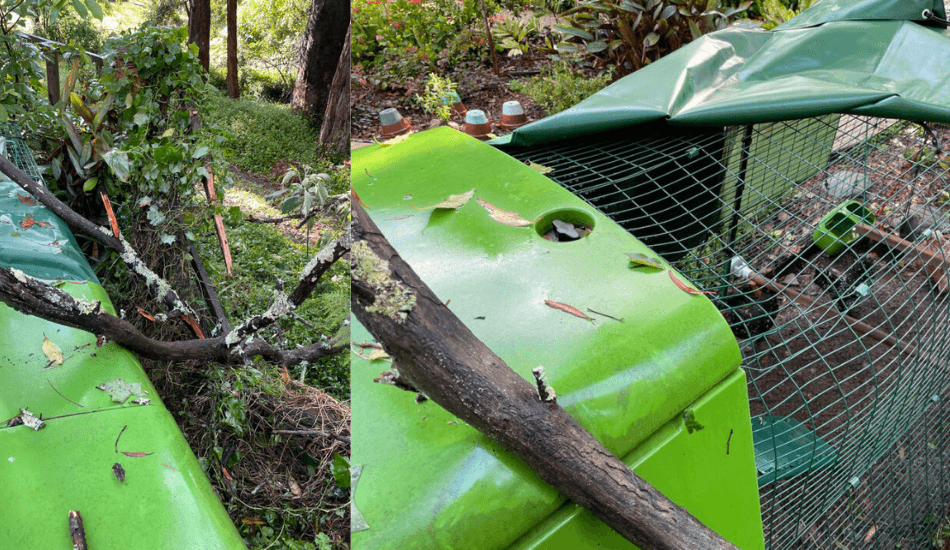
Months after replacing her rotten wooden coop, Ashleigh was relieved to find her hens unharmed after severe storms had blown down a large tree, crushing her fence, but stopped in its tracks by the reliable Eglu Cube chicken coop.
“We’ve had storms overnight and went to let the chickens out this morning to find a large tree had come down from the bush behind the house and had landed on our fence and chicken coop. The fence couldn’t withstand the impact, but the Eglu Cube did. We replaced our old wooden coop with the Omlet one a few months ago as the wooden coop was rotting in our humid mountain air, and we’re so glad we did. Not only is it so easy to clean, I don’t think our chickens would have survived the tree falling on the coop. The coop does need some repairs as the run and coop itself have buckled, but I still can’t believe how strong it is.”
Ashleigh – New South Wales, Australia.
Tornado – yep, this Eglu Cube survived one!
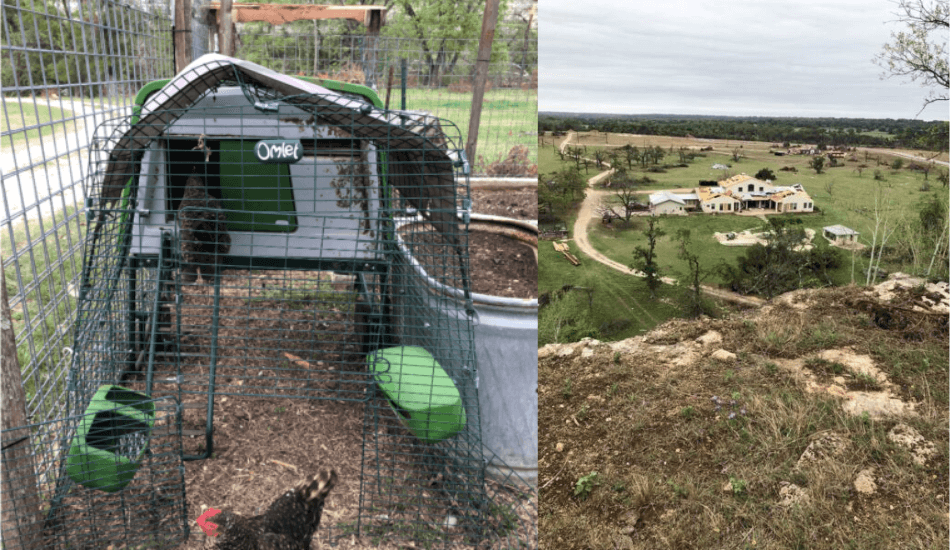
Despite needing a good clean and a reshape, Lori’s Eglu Cubes survived a direct hit from a severe tornado in Texas, and her hens were unharmed – though a little shaken by the whole thing.
“We sustained a direct hit from a F3 (almost F4) tornado in April. Much of our ranch was destroyed (hay barn completely gone, barndominium, horse stalls and woodshop required demo to slab, house currently unliveable). We lost two cows and many trees. But, we survived in our tornado room with our dogs and our 2 Omlet Cubes and all of our chickens survived. One Cube was completely upside down and the other was trapped by fallen tree limbs and debris. The chickens were trapped by our hawk netting that collapsed with the tree limbs; actually fortutios and I think they would have been blown away – ah, the story they could tell! We were able to turn the one coop upright and get them all in one for that first night. Yes, 12 wet hens can fit in an Eglu Cube!
While the run and skirting are bent up, and I had to remove a few pieces of skirting, they are still functional. The back door on one sustained a hit that broke a small piece of plastic that makes the handle a little loose, but still functional. The Autodoors still work, one of the shade covers survived, as did the food and water bowls! Other than being scratched up, very dirty and with misshapen runs, they are fine! They have since had a thorough washing and if you didn’t look at the bent run, you’d never know anything happened! Thanks for making such a great product!”
Lori – Texas, USA.
Eglu Cube – 1, Mountain lion – 0


Pesky predators are no match for the Eglu Cube. Watch how this crafty mountain lion in Arizona made several attempts of sneaking their way into the Eglu Cube. But with its unique indestructible and anti-predator design, even the biggest of cats are left baffled by this coop.
Dug Rothrock – Arizona, USA.
This Eglu Cube saved hens from the flames
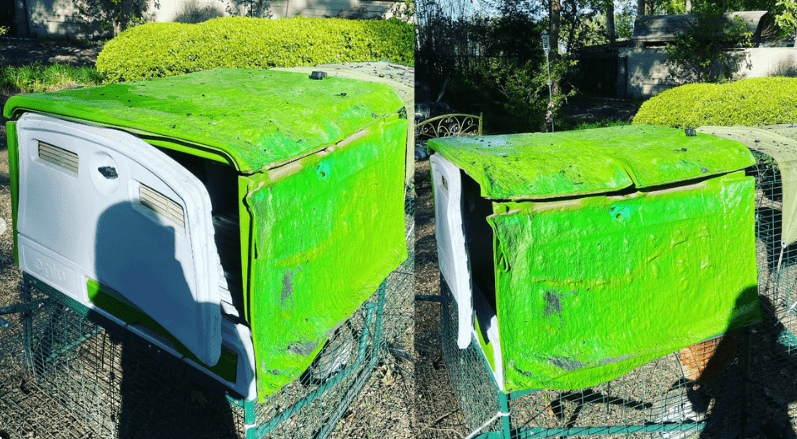

Disaster struck Erin from Arkansas when their backyard went up in flames. Fortunately, their hens were tucked safely away from the fire in their Eglu Cube chicken coop, which was able to withstand the terrifying event. Whilst the coop has been left with visual reminders of the blaze, Erins’s chickens survived thanks to the hard-wearing materials of the Eglu Cube.
Erin – Arkansas, USA.
So, how strong is the Eglu Cube chicken coop? From wild weather to wild predators, you and your chickens can rest easy with the Eglu Cube chicken coop, designed by Omlet and trusted by thousands of chicken keepers.
Got an amazing story to tell? If your Eglu has saved your hens from stormy weather or unwelcome visitors, please email us at blog@omlet.us.
This entry was posted in Chickens
Social Media Executive Rosie has been at Omlet for a year, and when she was asked by her managers if she was interested in broadening her chicken knowledge (and creating fun content for Omlet’s social media platforms) with her very own flock, she said yes straight away.
Since we last spoke to Rosie a few weeks ago, the 5 ex-caged hens have settled into their new home and are starting to discover the world outside the safety of their Eglu Cube and Walk in Chicken Run.
We let them out one nice afternoon after having had them on the run for a few weeks. They were quite hesitant at first, as if they didn’t really know what to do. But once they realized they could go and explore they absolutely loved it!
They have a few hours outside every day, and they run around on the grass, make dust baths in the borders and peck at everything. Before, we could go in and out of the run and they wouldn’t really be bothered about the door being open, but now as soon as we come to see them, they stand waiting to be let out and often try to escape between our legs. So they’ve definitely had a taste of freedom, and they love it!
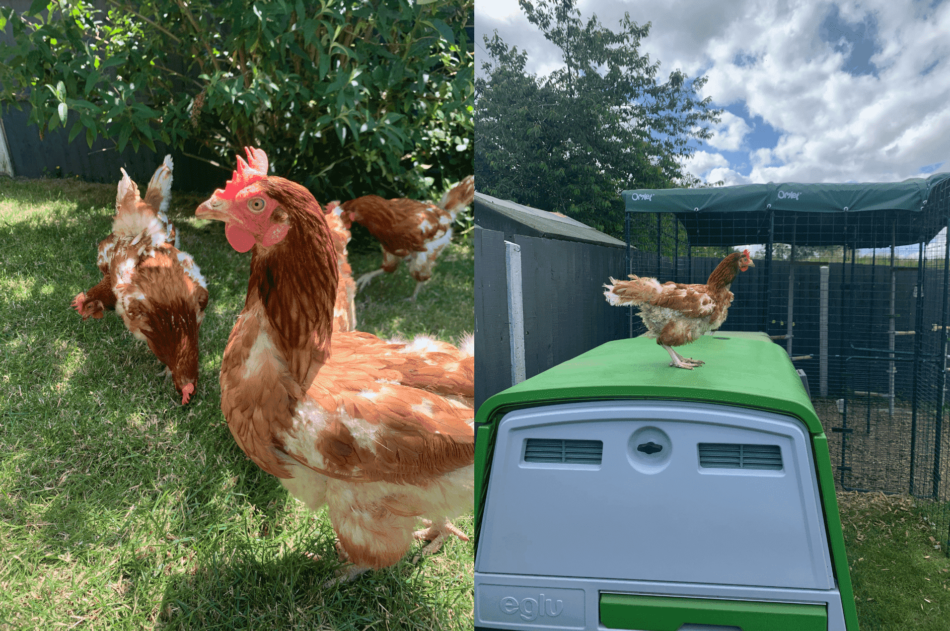
Have you had any luck with Evie the dog interacting with them?
We still keep Evie inside when the chickens are out, just because I’m not sure how she would handle it. More than anything I think she would just like to play with them, but probably a bit too rough.
We’re going to get some chicken fencing for when they are all out at the same time, to create a kind of barrier. Once they are used to each other I hope that will be fine.
What do the hens do for fun?
They use the PoleTree in the run all the time, when I come out in the morning they are already on there. They haven’t reached the highest perches yet, but they’re slowly climbing up.
So far, they haven’t been too bothered about the Freestanding Perch Tree. We have it out in the backyard, and I think they are just too busy exploring everything else when they are free ranging that they don’t want to perch. But once it’s not quite as much of a novelty it’ll be nice for them to have somewhere to perch outside the run as well.
What else has happened since we last spoke?
Their feathers are getting a lot healthier, you can really tell a difference from when we rehomed them. One of the hens has got more or less a full plumage with really shiny feathers, and she was the one that looked the worst to start with.
We’re still getting 3-5 eggs every day, so we’ve had to start giving them away to friends and family. We’re super popular guests now!
I also gave them some strawberries from the vegetable patch the other day, and they absolutely loved it – they were going crazy!
Any problems?
Not really a problem, but we live in quite a rural area and the neighborhood cats have definitely sniffed out the hens. We can see them sitting on the fence looking at the chickens when they are out in the garden, and there was a red kite circling over them the other day as well. I don’t know if they would actually go for them, but I’m glad they are in the Walk in Run when we’re not there though, so I know they are safe.
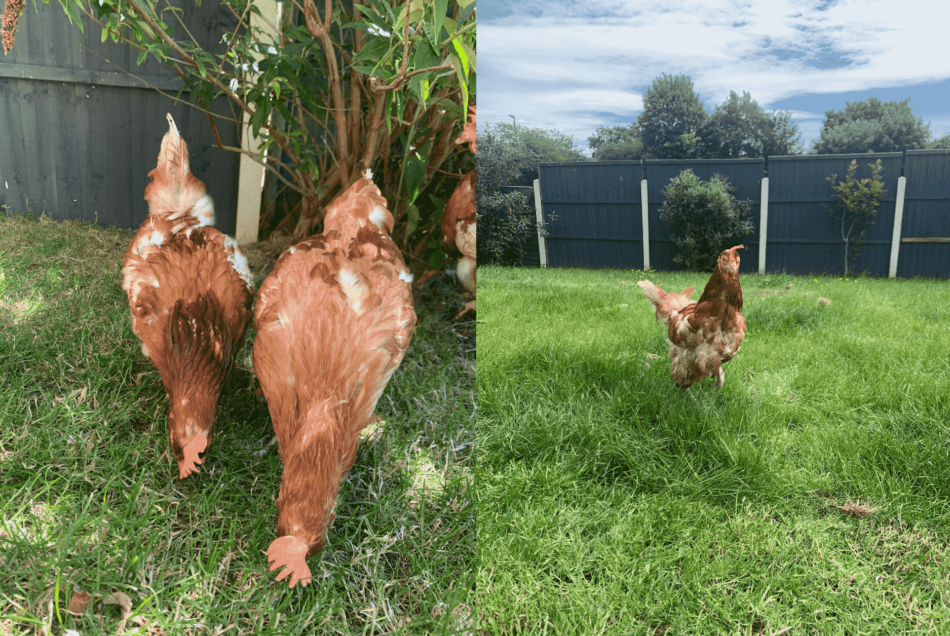
This entry was posted in Chickens
Holly Callahan-Kasmala is a freelance writer and livestock historian. Chrisie DiCarlo is a retired veterinary technician and veterinary trauma nurse. Together, they have over 26 years of combined chicken care experience. They are the creators and cohosts of Coffee with the Chicken Ladies Podcast.
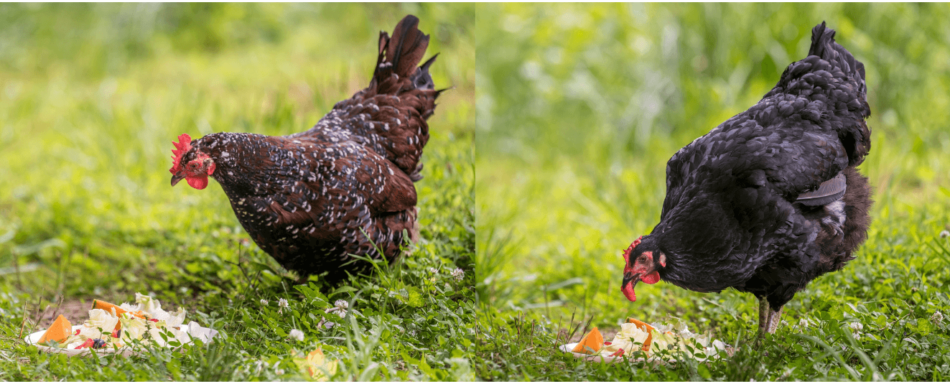
Summer is fast approaching and hot weather with it. This is the time of year that we get to enjoy garden fresh flowers and produce, but it also means protecting our flocks from overheating. This summer will mark our combined 28th year of chicken care in the hot and humid mid-atlantic. So, we’re going to share our top tips for tried and true ways to help keep your flock cool. Make sure you read to the end for our favorite summer snacks and treats.
The first and most important thing you want to provide for your flock is shade. A shady spot lets your chickens escape the hot sun. Direct sunlight can make temperatures feel as much as 10-15 degrees higher. Your flock’s water sources should also be kept in shade. All water containers, especially enclosed ones, will capture and hold heat from the sun. We keep extra ice on hand and liberally add ice to the chickens’ drinking water during the hottest days.
Trees are a great source of natural shade, but you can also provide human made shady spots. Hang sun shades made from sailcloth, canvas, even light colored natural fabrics that can help deflect the sun’s rays and create shadowy spots. Don’t forget to utilize the space beneath your chicken coops. Omlet coops that sit on stands create a great space for your chickens to go under for water and cool dirt.
Coops can get pretty hot during this time of year. Shade helps, but there are some other things you can do to bring down the temperature in your coops. We’re big advocates for careful use of fans with small grids (small enough that feet and beaks cannot fit in.) You can use either electric or battery powered, but our favorites are the battery powered fans. You can buy them with rechargeable batteries, and not have to worry about cords and power loss to the coops. We turn them on in the evenings and they help pull air through the coops. In our Eglu Cubes Chicken Coops, we simply zip tie a small battery powered fan to the inside of the back vent and let it create a cross breeze.
Ice packs, both store bought and homemade, are another great tool to utilize against heat stress. They’re very easy to make, simply wash and fill various sizes of plastic water or juice bottles with clean water and pop them into your freezer until they’re solid. You can use the frozen bottles in your run, or you can put one in a shallow pool or bowl and let your chickens wade in to cool off their feet. At night, a large bottle or ice pack can be wrapped up (to keep them clean) and placed into your coop. This is especially beneficial in Omlet coops – they’re so well insulated that an ice pack will substantially bring down the temperature in the coop. This is a life saver here in Maryland where it’s sometimes still 80F+ degrees when we’re closing up for the night.
With a normal body temperature of about 105F degrees, chickens really appreciate snacks and feed that are cooling and hydrating. The simplest thing that you can do is place some of their regular ration in a resealable bag and pop it into the refrigerator or freezer for a few hours. You can also go the extra mile – make a mash by adding water to your chicken’s feed, stirring in berries or other cut up fruit, and freezing it in a silicone mold. Your birds will love you for serving them this fancy treat. Recipe below!
There are several other foods that you can either buy or grow to treat yourself and your chickens, too. Melons of almost every type are about 90% water and contain lots of electrolytes as well as other nutrients. This is also some evidence that lycopene, an antioxidant found in watermelon, cantaloupe, and some other melons, can help reduce the risk of heat stress in poultry.
Chickens can eat almost every part of a melon. Everything from the seeds to most of the rind is edible. We like to cut chilled melon for ourselves, and leave a bit on the rind for the chickens. They love it!
Cucumber is also a wonderful, juicy summer treat for your poultry. You can cut it into pieces or feed it whole, with or without skin. If you do peel the cucumber, compost the pieces so that none of your flock get them stuck in their crop. Our chickens especially enjoy cucumber when it’s been chilled for a while.
You can make your flock a fruit salad for an afternoon snack. Line a small dish with some crisp, cool iceberg lettuce, and layer on some berries, cut up grapes (whole grapes can be a choking hazard,) diced apples and pears, and top with a few baby greens from your garden. You can also forage some young dandelion greens if you don’t have anything else nearby. Our exact recipe is below.
Heat stress is a very real danger for chickens and other poultry. With some planning, you can help your flock get through the worst of the summer weather. A combination of shade, cool water, ice, and some hydrating snacks can help keep the summer season fun for you and your birds.
Frozen Berry and Crumble Molds
2 cups of your flock’s regular crumble feed (pellets work but need to soak longer and may need more water)
2-3 cups of water or more, as needed
1 cored and cut up apple
1 cup of berries (we used a mix of whatever we have on hand)
In a medium sized bowl, mix the feed and water together and allow to sit for at least 5 minutes. You want the mash to be wet but not too sloppy.
Mix the fruit pieces into the mash and spoon it into silicone baking molds. You can use muffin tins or other molds but it’s easiest to get the finished product out of silicone.
Place molds in the freezer for about 30 minutes. When you’re ready to serve, pop the crumble out of your mold and serve on a plate or dish. Watch your happy chickens enjoy!

Iceberg Salad for the Birds
1 head of iceberg or other crisphead lettuce, washed
1 handful of grapes, cut into quarters
1 handful of berries, any kind
1 cup of melon pieces and/or leftover melon rind and seeds/strings
1 small handful of baby greens or sprouts
1 dollop of unsweetened yogurt (optional)
Find a chicken-safe platter or shallow bowl. Pull the lettuce into big pieces and line the dish with them. Place the melon pieces and any rind on top of the lettuce. Scatter the grapes and berries around the platter and top with the greens. If you want to gild the lily, you can dollop a small amount of unsweetened yogurt on top. Serve this treat to your flock on a hot afternoon and watch them dig in!
This entry was posted in Chickens






















































